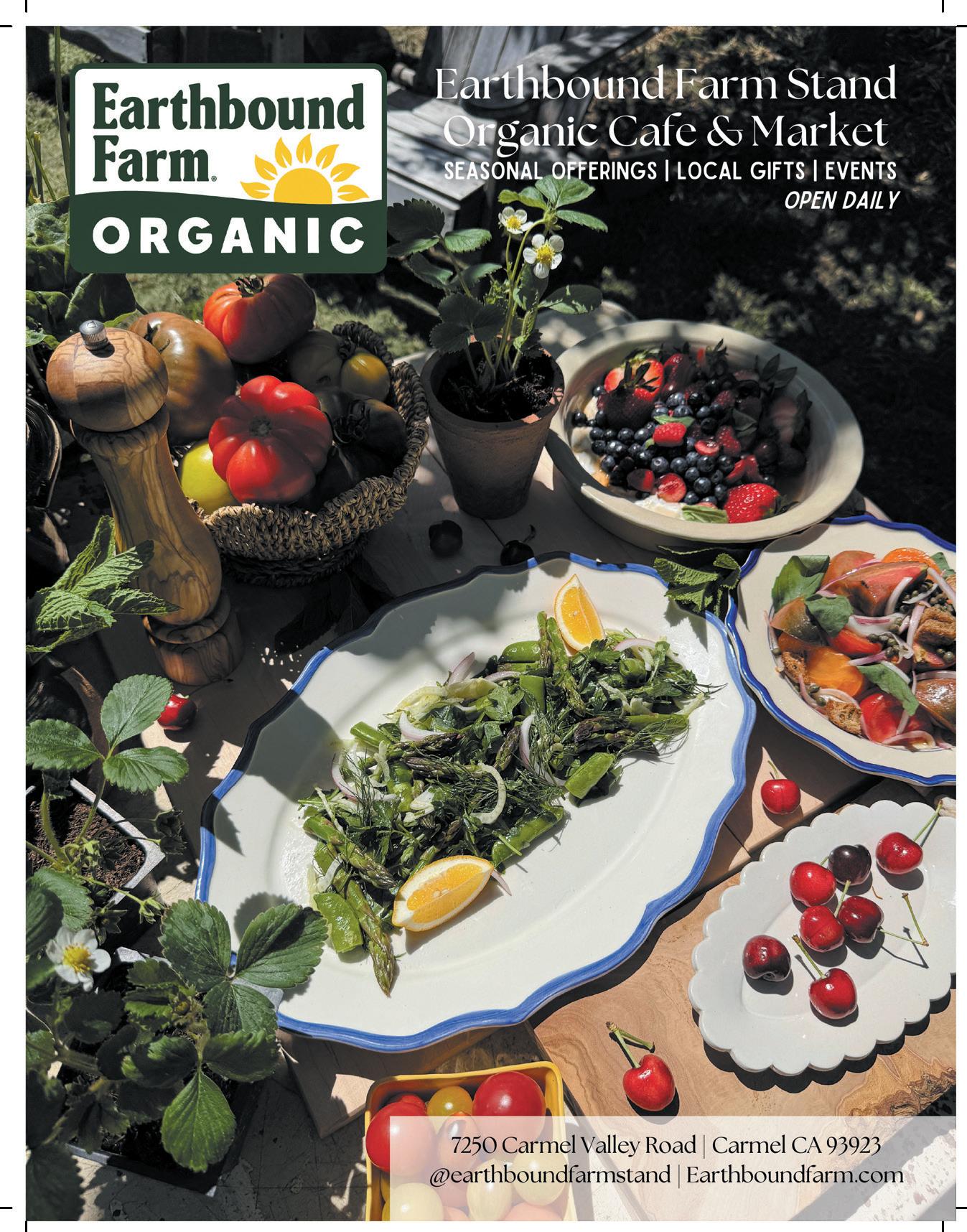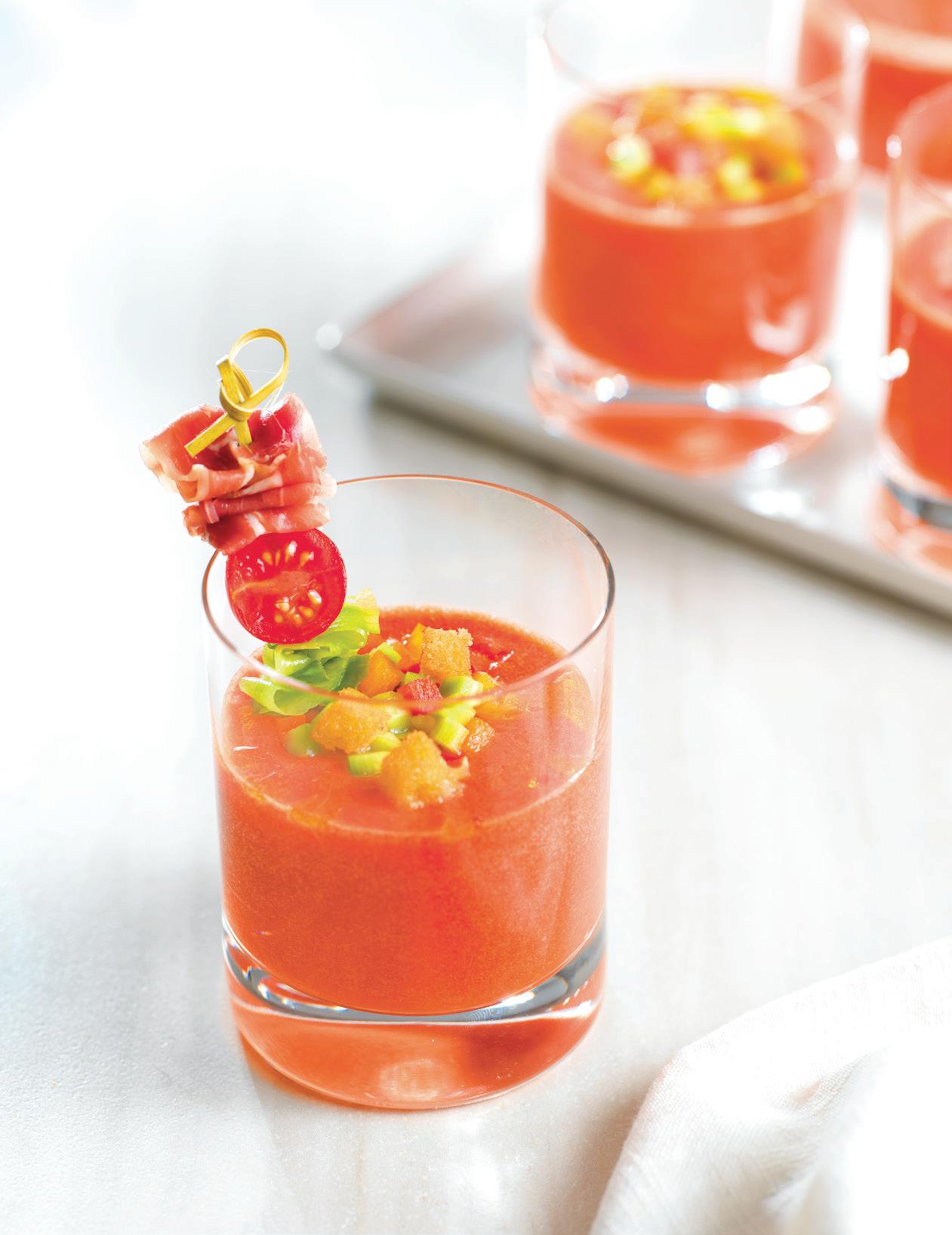
Celebrating the Local Food and Drink of Santa Cruz, Monterey and San Benito Counties




Celebrating the Local Food and Drink of Santa Cruz, Monterey and San Benito Counties
















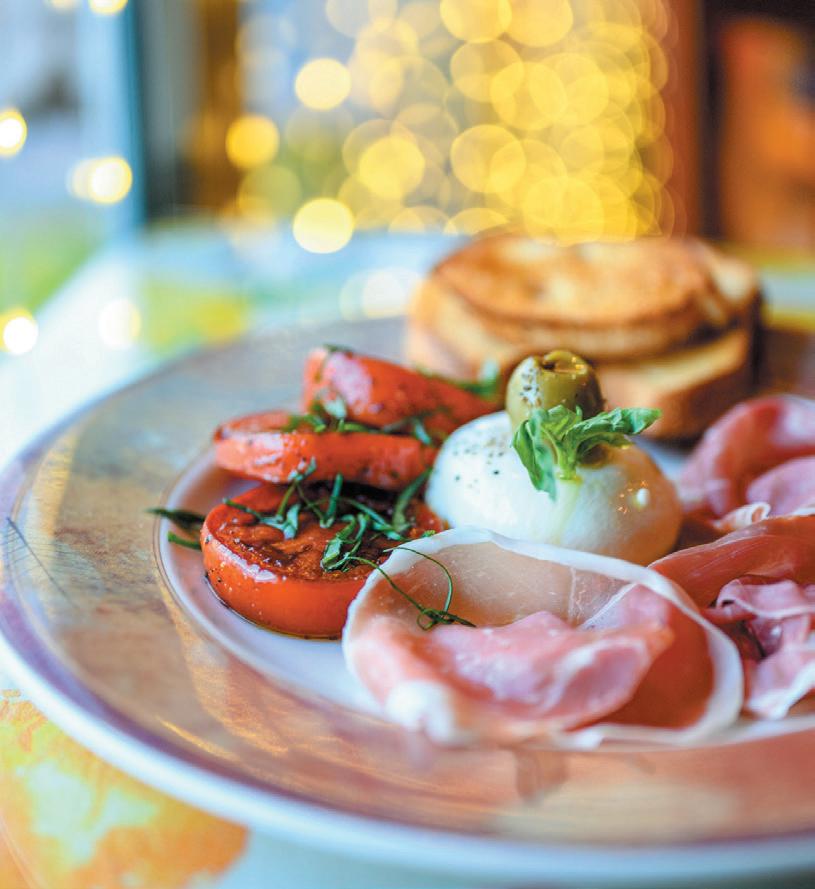

Chasing

A cosmic connectivity of time and place accompanies an adventure in the
A West Coast road trip inspires ingredient-driven
A landmark Japanese-Michoacan fusion hub also does divine
Etto Pasta alla Norma 71 Roasted Snap Pea Salad with YakultStyle Dressing
COVER PHOTOGRAPH
Patrick Tregenza
CONTENTS PHOTOGRAPH
Mark C. Anderson





Mother Nature is putting on her usual summer show with vibrant flowers, sweet strawberries and juicy stone fruits, but many people I know are not feeling the usual joy this season brings.
There’s a sense of unease and uncertainty in our community—about pocketbook issues like rising prices and possible shortages; about the erosion of public services; and about the well-being of the local farm labor force.
People often say what is happening this year makes them feel helpless, but regular readers of Edible Monterey Bay know that eating locally is part of the solution and something anyone can do. We’ve always believed that real change begins at the table.

“Local food isn’t just about what’s on your plate; it’s about who you’re standing with,” says Edible Communities co-founder Tracey Ryder. “Every time you visit a farmers market, choose food grown nearby, or dine at a restaurant that sources locally, you are investing in your neighbors, your environment, and the unique food culture that makes your community home.”
Now more than ever choosing local is an act of resilience. “When we support the farmers, ranchers, fishers, and makers in our own regions, we help create a more secure and sustainable food system—one that nourishes us, even when global systems falter,” she adds.
With this new issue of Edible Monterey Bay, we invite you to meet some of the people who are making contributions to the local foodshed, in both large and small ways—by making pickles, spotlighting forgotten vineyards, baking, cheffing and creating a new farm designed to be a model of regenerative agriculture for all of California.
And we report on two organizations—the Center for Farmworker Families and the Campaign for Organic & Regenerative Agriculture—that have teamed up to make the Pajaro Valley healthier for field workers and all residents, especially children.
We would also like to invite all our readers to attend the Summer Issue Release Party, taking place Wednesday, June 25, from 5pm to 7pm at Heirloom Pizza, 344 Main St. in Salinas. It’s a perfect opportunity to meet fellow members of the EMB community and get to know some of the new businesses that are helping revive Downtown Salinas.
Hope to see you there!

Deborah Luhrman Publisher

EDITOR AND PUBLISHER
Deborah Luhrman
deborah@ediblemontereybay.com
831.600.8281
FOUNDERS
Sarah Wood and Rob Fisher
MANAGING EDITOR
Mark C. Anderson
COPY EDITOR
Doresa Banning
LAYOUT & DESIGN
Matthew Freeman and Tina Bossy-Freeman
AD PRODUCTION COORDINATOR
Tracy Smith
AD DESIGNERS
Louise Androlia • Julie Greene • Coline LeConte • tracysmithstudio • Sarah Williams
CONTRIBUTORS
Kera Abraham • Analuisa Béjar • Jamie Collins • Otis Conklin • Robert Eliason • Cheyenne Ellis • Kelly Rose Evans • Agnieszka Kazmierczak • Alex Luhrman • Michelle Magdalena • Laurel Miller • Laura Ness • Ashley Drew Owen • Hanif Panni • Geneva Rico • Josh Rose • Patrick Tregenza • Amber Turpin
ADVERTISING SALES
ads@ediblemontereybay.com • 831.600.8281
Shelby Lambert shelby@ediblemontereybay.com
Kate Robbins kate@ediblemontereybay.com
Aga Simpson aga@ediblemontereybay.com
Fran Fitzharris fran@ediblemontereybay.com
DISTRIBUTION MANAGER
Mick Freeman • 831.419.2975
CONTACT US: Edible Monterey Bay P.O. Box 487 Santa Cruz, CA 95061 ediblemontereybay.com 831.600.8281 info@ediblemontereybay.com
At Edible Monterey Bay , our mission is to celebrate the local food culture of Santa Cruz, San Benito and Monterey counties, season by season. We believe in sustainability, and we believe everyone has a right to healthful, clean and affordable food. We think knowing where our food comes from is powerful, and we hope our magazine, website and newsletters inspire readers to get to know and support our local growers, fishers, chefs, vintners and food artisans.












Chris Ley’s pickle business was created from the ground up
BY LAUREL MILLER
PHOTOGRAPHY
BY
OTIS CONKLIN
While many of us spent the early days of the pandemic hoarding toilet paper, collecting unemployment and experimenting with sourdough, Chris Ley was launching a business.
It wasn’t a conscious decision, at first.
But for the founder of Royal Oaks-based Freckle’s Pickles, the pandemic-driven food supply shortages sparked a desire to become more self-sufficient—and take his future into his own hands.
Ley was working as a lab tech manager in March 2020, and his wife-business partner Debbie was a hairstylist who found herself out of a job due to COVID closures.
The couple soon decided to take on growing their own vegetables for the first time, and planted “a little of everything,” including a dozen types of pickling cucumbers.
“I had no idea there were so many varieties,” says Ley, a selftaught cook who, at the time, had never tried preserving food.
He threw himself into gardening, reading up on how to build and amend soil—and preserve produce.
Meanwhile Ley learned to cook, educated and inspired in part by watching The Food Network on overnight shifts as a home health caregiver.
Inspiration also emerged when his boss, whom Ley describes as “a very frugal guy,” came in with expensive fresh pickles from Whole Foods.
“I thought, ‘If he’s spending this much on pickles, they must be good,’” Ley says. “They blew my mind.”
Ley embarked on making his own fresh pickles sourced from his garden. He began giving them as gifts to coworkers and friends and, he remembers, “They went nuts.”
“They started asking if they could buy them and it became a running joke that I was going to start a pickle company,” Ley says.
The couple was, in fact, struggling to get by on a single salary, so Ley made a decision to go all in on launching a pickle company. In October of 2021, the Leys debuted their homegrown and homemade products at a makeshift stall on Pacific Avenue in Santa Cruz.
At the moment, Freckle’s Pickles can be found at 10 farmers markets throughout Santa Cruz, Monterey and Santa Clara counties, as well as Shopper’s Corner in Santa Cruz, Barn Fresh Produce in Moss Landing, Radici Market in Carmel Valley and Quality Market & Liquors in Salinas, as well as the odd brewpub.

plains—is more than coincidence or timing, however.
Debbie continues to be surprised at the raw enthusiasm they encounter as they pass out samples and, often enough, a small crowd forms.
“People’s reactions have been crazy!” she says, noting the uncooked crispness of their style has been a difference maker. “I had no idea people were going to be like, ‘Oh my gosh!
Freckle’s Pickles sold out in three hours at their first farmers market appearance. “I don’t want our products in big chains,” says Chris Ley, pictured with Debbie. “My vision is to sell in local groceries and other stores, and hopefully people will support that.”
These pickles!’”
The success of Freckle’s Pickles—“My wife and I are both redheads,” Ley ex-
“My entire life, I’ve been very passionate about books like Napoleon Hill’s Think and Grow Rich!,” he says. “I’m a big believer in the power of positive thinking, and I thought, if my coworkers believe in me, I can do this.”
After the Leys started their pickle business, they were sourcing a portion of their cucumbers from their home garden, a practice that continued until Jan. 16, when the Moss Landing Battery Fire happened (see sidebar, page 9). The remaining cucumbers and other produce (garlic, chiles and herbs) come from growers throughout California, with an emphasis on Monterey County.
After the fire, the couple stopped using their homegrown produce, which include additive-free flavors like Dill-Garlic, Mild Jalapeño, Hot Habanero and Carolina Reaper.


“We change people’s minds about pickles every day.”
“People kept asking for hotter varieties,” says Ley, who adds a bit of sugar for balance. The company also offers a sugar-free medium serrano, while Ley works on developing sweet and classic dill relishes, and a sweet pickle.
What proves ubiquitous along the way is the process Ley uses to make his products— avoiding the method of heating through pasteurization to make them shelf stable, or adding dyes.
“‘Shelf pickles lack the health benefits of other types of pickles because the heat destroys the good bacteria as well,” he says.
Part of what sets Ley’s fresh pickles apart from their fermented brethren is their bright green color and snappy texture. Ley keeps his exact recipe secret, but notes that he uses mostly organic ingredients along with kosher salt and distilled white vinegar.
“The magic is in the brine,” says Ley, adding that the use of fresh herbs also amps up the flavor.
Freckle’s Pickles are made in a commercial kitchen in Santa Cruz, though Ley has plans for extended production.
“I want to grow organically, eventually expanding to other regions and sourcing locally within those regions to support farmers,” he says.
As far as the immediate future goes, Ley is plenty busy just making pickles.
“They’ve become my passion—my wife says I was meant to do this, although I couldn’t have done it without her,” he says. “If you have a positive mindset, a small business can become a self-fulfilling prophecy, even with something as random as this. We change people’s minds about pickles every day.”
Laurel Miller, former editor of Edible Aspen, grew up on a California ranch and has been writing about regenerative agriculture for over 20 years. She enjoys backpacking, agave spirits, and street tacos, not necessarily in that order.
Fresh: Also known as refrigerator or cold cured pickles, these crunchy pickles are made by soaking cucumbers in a vinegar-based brine at room temperature, have probiotic benefits and work as garnishes, snacks and grazing board accents.

Fermented: Also called kosher or half sours, brined in vinegar at room temperature, have the highest probiotic content, and moderate crunch, great in sandwiches or on a charcuterie spread.
Shelf stable: Pasteurized (heated) and made with vinegar. The application of heat destroys good bacteria, can be made with dyes and additives, have a softer texture.
The fallout of the Battery Fire smolders on
On the afternoon of Jan, 16, a fire broke out at the world’s largest lithium storage facility, located in Moss Landing. The incident prompted the evacuation of more than 1,000 residents.
The fire resulted in a class-action lawsuit by several Moss Landing parties against Vistra Corp, the Texas-based power company that owns the facility.
According to a memo from the office of John Laird, California state senator for District 17, the California Department of Toxic Substances Control (DTSC) conducted preliminary soil testing at select sites near Moss Landing, with surface screenings of ash and debris detecting elevated levels of heavy metals, and deeper soil samples and sites further from the fire revealing no higher concentrations.
In the hours, days and weeks after the fire, Moss Landing residents complained of various ailments.
Those included a metallic taste in their mouth, headaches, nosebleeds and sore throats. In addition to heavy metals, lithium-ion battery fires release carbon monoxide, hydrogen fluoride and volatile organic compounds that carry the potential for serious respiratory and neurological issues, particularly in children, the elderly and those with compromised immune systems.
Researchers from San Jose State University’s Moss Landing Marine Laboratories (MLML) have discovered an increase in heavy metals in the Elkhorn Slough Reserve, adjacent to the battery plant.

Many of the region’s farmers, however, have been left to deal with the fallout on their own.
Delmar McComb of Blossom’s Farm has two sites on Jensen Road in Moss Landing. The farm, which grows herbs, vegetables and strawberries, eschews chemicals and uses biodynamic practices, including making herbal plant health tonics, growing cover crops for soil improvement and using certified organic inputs when needed.
Although their sites are upwind of the fire, McComb says he is “deeply disturbed and frustrated by this incident.”
He and his business-life partner Carin Fortin paid more than $500 out of pocket for soil testing to ensure their land was safe. The results confirmed that the farm didn’t suffer any contamination as a result of the fire, although McComb plans to retest.
McComb does, however, note that the metals resulting from the fire are naturally occurring in the human body and in soil. “Just as with human health, some metals, in small quantities, are required by plants in order to assimilate other nutrients,” he says. “Obviously, heavy concentrations of metals in the soil or body are toxic, but low levels are normal. Our soils tested low or very low on all, so we feel good about the results.”
Farmer Delmar McComb says he is “deeply disturbed” by this incident.
“It’s clear that much of the heavy metals resulting from the battery fire are from aerosol fallout,” says Ivano Aiello, professor and chair at MLML.
Aiello and his team have, during their study, been testing the soil, water and invertebrates of the slough. Following the main precipitation events in February, his team started noticing a dramatic decrease in surface concentrations, he adds.
“There were also larger visible burned fragments found up to 3 kilometers away from the site of the fire,” he says. “The surface of the soil also contained very small particles of metallic material that is used to make cathodes in batteries.”
He also notes that the increase in concentration of manganese, nickel and cobalt in the marsh soils was two to threefold compared to previous measurements, most of which were done in the summer of 2023.
As a result of the fire, Senator Laird introduced the Clean Energy Safety Act of 2025, which aims to, among other objectives, increase battery storage safety. His office continues to collaborate with local officials to “amplify their requests at the state level and advocate for further resources,” which includes helping to secure outside funding for MLML to conduct environmental testing.
The farm also reports that no state or local agencies have reached out since the fire. When Edible Monterey Bay contacted California Certified Organic Farmers (CCOF) for comment, reps referred to the organization’s official statement.
“CCOF has been in communication with the California Department of Food and Agriculture (CDFA) State Organic Program (SOP) and Monterey County agricultural officials,” it reads. “At this time, CCOF, the SOP and the Agricultural Commissioner’s Office are not conducting independent sampling. However, the County Environmental Health Bureau is analyzing soil samples collected by DTSC and sharing results with county officials. CCOF has contacted all operations that it certifies within a three-mile radius of the incident and, to date, has not identified contamination of organic land as an issue.”
Edible Monterey Bay will keep readers updated on the agricultural and marine effects of the Battery Fire as they develop, via ediblemontereybay.com.
—Laurel Miller


Regenerative California seeds a farm with an eye toward inspiring an industry
BY ASHLEY DREW OWEN PHOTOGRPAHY BY MARK C. ANDERSON
Native grasses leap from rolling hills that glow green in spring and turn gold by summer.
Small clumps of ancient oaks with gnarled branches cast dramatic silhouettes from above a soft expanse of rich farm dirt.
The air carries a hint of the Pacific, and the land sprouts wildflowers like yellow mustard, rose clover, purple vetch and three types of lupine.
This pastoral 866-acre property where Highway 68 meets River Road in Salinas, long known as Ferrini Ranch, bursts with classic Central Coast scenery.
And, after many iterations—from wild untouched land to an 1800s cattle ranch to a decades-long battleground for conservation and development forces—it now bursts with potential impacts well beyond this part of The Golden State.
Conservation won in late 2024, when Big Sur Land Trust (BSLT) acquired the entirety of Ferrini Ranch and tapped a new organization called Regenerative California to take over a 68-acre parcel there.
The vision is to build a farm that grows food and flowers, hosts workshops and shares land with organic farmers, and furnishes a model for agriculture that feeds people, supports workers and revitalizes the land.
Plastic- and fertilizer-intensive strawberry plots have been healed with steady attention from Regenerative California’s lead farmer, TJ Silva, who also manages farming operations at Earthbound Farm.
Silva and his team are planning where they’ll plant zinnias, sunflowers and dahlias to attract pollinators, while vegetables like Swiss chard, beets, winter squash and green beans will line rows interspersed with thyme, parsley and other herbs.
Over time, perennials and fruit trees will root down and become fixtures too.
“We believe farms should heal the land, water, air and the community,” he says. “Beauty is essential and this location has so much beauty already surrounding it.”

TJ Silva sifts through the soil at the Regenerative California farm—which seeks a compelling name (see sidebar, page 13)— checking moisture, texture, organic matter and earthworm presence. “We want to see life in the soil,” he says.

The ranch has long been a significant property.
That’s due to its size (which totals roughly 656 football fields), its unique location (situated amid farmland connecting two cities) and stunning natural spaces (framed by the Sierra de Salinas range).
The property also borders Fort Ord National Monument and Toro Park, representing the final link in a massive plot of protected land.
It is home to species like bobcats, mountain lions, foxes, American badgers and the Monterey dusky-footed woodrat, serving as a wildlife corridor used by hundreds of animals a year.
When its previous landowners proposed plans to build luxury homes in the 1970s, local environmental groups successfully blocked them, citing the wildlife, strained water resources and wildfire risk.
BSLT President and CEO Jeannette Tuitele-Lewis notes this plot is part of the Trust’s broader preservation efforts in the zone, which stretch across nearly two decades and 10,000 surrounding acres.
She sees the Regenerative California farm as a prime example of how conservation projects can benefit the environment and community alike.
“Ferrini Ranch is an opportunity to look at how we combine regenerative agriculture with protection of a critical wildlife habitat within a scenic recreational and parklands corridor,” she says.
United by complementary missions and shared landscapes, Regenerative California and BSLT have been connected since 2023, when the former’s CEO and co-founder, Kristin Coates, first launched the nonprofit.
The organizations have collaborated on various research and projects, and Tuitele-Lewis is an adviser to Regenerative California. Early

on, Coates mentioned to Tuitele-Lewis that if BSLT ever acquired a property like Ferrini Ranch, it could be the perfect place for Regenerative California’s inaugural farming project—and what seemed like a lofty wish soon became a concrete plan.
“Land conservation organizations are typically known to put velvet rope around a piece of land,” Coates says. “But Big Sur Land Trust understands that humans are part of the ecosystem too. So we’re learning the role of agriculture in that ecosystem to provide a healthy, stable regional food supply.”
Since securing the land, things are moving fast for the yet-unnamed demonstration farm—which inspires a community invite to propose names for their new farm (see sidebar, page 13).
In addition to tending the soil, Regenerative California also will make the farm accessible to other growers in the region.
Local farmers will have a chance to lease land, starting with a handful of graduates of the Salinas-based Agriculture and Land-Based Training Association (ALBA), a nonprofit dedicated to creating great produce and economic opportunities for aspiring organic farmers, particularly those from limited-resource backgrounds.


Beyond growing food, this will be a place to test big ideas.
Educational events and workshops will pass on techniques for maximizing organic vitality, from cover cropping and pollinator programs to worm tending and making compost tea.
The team will also showcase innovative approaches, like finding ways to increase the food’s nutrient content, a passion project of Jamie Collins, Regenerative California’s farm programs and engagement manager (who also is a regular contributor to Edible Monterey Bay).
“As regenerative practices are put in place and we’re rebuilding soil health and all that, we can actually analyze the food and see that the nutritional value is higher,” she says. “That [nutritional value is] being depleted because of conventional farming and erosion of topsoils…We’re not getting the food we did back in the day.”
Collins is also preparing to host events like seasonal crop celebrations for staples like strawberries and tomatoes, showcasing their histories and innumerable varieties. She envisions inviting local chefs to lead classes like salsa- or Bloody Mary-making workshops during peak tomato season.
Far left, Kristin Coates does farmers market reconnaissance. Back at the farm, pipes ready to be built into rolling overhead irrigation devices, chunky dirt, pollinator-friendly wildflowers, cover cropping, compost amendments and minimal tilling hint at the strategic soft touch already at work. “Get that organic matter up!” says Silva (bottom right).
The regenerative farm project is a collaboration.
So is naming it, with your help.
Readers are invited to submit fun, creative and heartfelt suggestions to info@regenerativecalifornia.org; if your farm name is chosen, you will receive one of the first harvest boxes of farm produce, and 10 boxes will be donated in your name as a humble thank you.
The winning submission will also be recognized in a future publication of Edible Monterey Bay.
As Regenerative California CEO Kristin Coates notes, working together is foundational to their endeavor.
“We have to acknowledge the fact that we don’t operate in silos,” she says. “It’s not just the land production of food, it’s not just the ocean production of food, it’s not just housing being an issue. They’re all inter-related. And all of these have an impact on the ecological, social and economic prosperity, and the health and resilience of this community.”
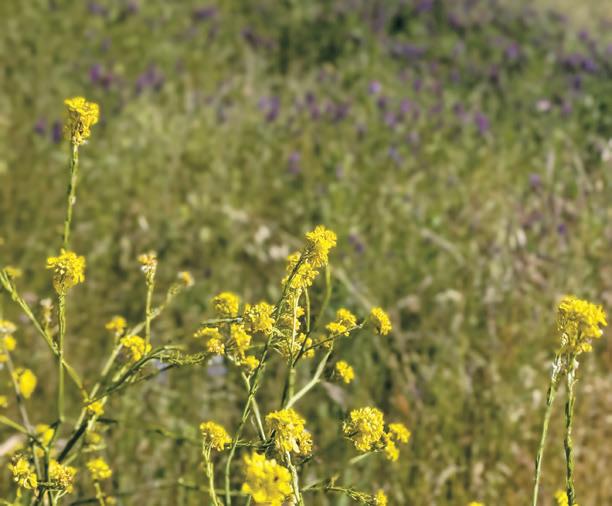

The farm also has its sights set on confronting bigger issues in agriculture. Land access and land tenure are at the top of the list.
Many small to midsize farmers are only offered short-term leases, which leads to them growing more high-yield annuals. Over time, that high-intensity growing can deplete soil nutrients and make it difficult for anyone to grow anything, which inspires Regenerative California to pilot long-term subleases to their farmers.
“It starts with an access issue,” Coates says, “but it actually has this sort of cascading effect on the ecological, economic and social aspects.”
BSLT Director of Stewardship
Patrick Riparetti anticipates a balance of land management and smarter systems at the former Ferrini Ranch. “This project is a pivotal step in preserving the natural landscape while promoting innovative farming practices,” he says.
Another challenge in Regenerative California’s sights is the supply chain. Regenerative California is partnering with Rancho Cielo to build a farm stand right on the property, visible from adjoining River Road. This will allow growers to sell their products directly to community
“If we want to move towards a regenerative economy, we have to show what it looks like.”
members, while retaining 100% of the profits.
The organization is also working with local restaurants, retailers and institutions to supply food directly, and planning crops based on partner requests.
Come fall, places like Sierra Mar at Post Ranch Inn, Aubergine in Carmel and the Monterey Peninsula Unified School District will be serving produce grown on the farm.
“One small farm is not going to change the system, but we need signals that show how [growing food] can be done differently,” Coates says.
Though the team only recently broke ground, Regenerative California’s project is earning attention. They are fielding queries from ag tech companies, biological growing suppliers and other organizations that want to test products on the farm.
Their work is even featured alongside environmental pioneers like Patagonia and Guayakí Yerba Mate via a new book, Regenerative Economics, which highlights notable changemakers around the world.
“We live in a moment of time of a lot of talk,” Coates says. “If we want to move towards a regenerative economy, we have to show what it looks like, not just talk about what it looks like.”
Ashley Drew Owen’s passion for learning about local food is only overshadowed by her passion for writing about it…or eating it. When she isn’t writing, she can be found exploring nature with her dog Fenn, making music or baking elaborate desserts with foraged fruits.




Private Property showcases underappreciated Monterey County sites
BY LAURA NESS
PHOTOGRPAHY BY MICHELLE MAGDALENA AND JOSH ROSE
Scott Caraccioli made it his mission to craft the finest sparkling wine possible in the Santa Lucia Highlands, from Escolle Vineyard, under the Caraccioli Cellars label.
Now he’s turning his attention to lesser-known vineyards in the region, with the label Private Property.
“Escolle Vineyard is the backbone of the Caraccioli Cellars style: elegant, age worthy and collectible,” says Caraccioli, fourth generation farmer and grape grower. “Private Property allows me to offer wines in a fresh and fruit-forward style from previously under-the-radar Monterey vineyards.”
Caraccioli Cellars was launched in 2006 by brothers Gary and Phil Caraccioli, who have operated a large produce company for generations. Gary’s son Scott studied with the late Michel Salgues, a Champagne Roederer-trained Frenchman with experience in methode champenoise, and created a stunning French cave-like Carmel tasting room and sophisticated packaging worthy of the juice.
The buzz was instant. The rewards were many.
Caraccioli Brut and Brut Rosé consistently won both domestic and international awards, including four consecutive titles for Best Sparkling Wine in the USA at the Champagne & Sparkling Wine World Championships, drawing new visitors to the region and earning placements on top restaurant lists.
But with success came constraints.
“Caraccioli Cellars is very regimented,” says Scott. “We are carefully farming one specific site to produce a sophisticated, age-worthy product.”
In addition, Caraccioli Cellars sticks
exclusively to four varietals (Chardonnay, pinot noir, gamay noir and syrah), and each bottle of sparkling ages up to 58 months before release.
Talk about delayed gratification.
Private Property can bring good wine to market faster, and with greater freedom.
“Private Property is youthful and approachable,” Caraccioli says. “It’s all about showcasing the fruit.”
That’s born out in the audacious and searing sauvignon blanc, and the boldly adventurous gamay and syrah blend, which does cartwheels across your palate.
The Private Property sparklings age only 18–30 months. Where oak is used for aging, it is mostly neutral.
“Basically,” Caraccioli says, “these are pretty naked wines.”
While vineyards like Double L, Doctors, Garys’, Pisoni and Rosella’s have raised the Santa Lucia Highlands to cult status, Caraccioli believes a whole host of other SLH vineyards will prove worthy of recognition in their own right.
“Private Property gives me an opportunity to showcase what’s in my backyard,” he says. “It’s a remarkable quilt of what makes up Monterey County. It celebrates our agrarian roots. This is home for me. I want to celebrate other people’s dirt.”
Navigating the Salinas Valley grapevine, he uncovers producers growing the varietals he seeks, from the soils he prefers, in conditions he favors, with farming practices he prioritizes.
“Sourcing grapes is a different skill set than farming your own vineyard,” Caraccioli says.
His hunt led to a gnarly Tablas Creek clone grenache on the old Hook Vineyard, which he felt would be perfect for a juicy rosé he had in mind. Then he found the perfect pinot noir to complement it from the top of the Leven Valley Vineyard, south of Escolle, which happens to be in the middle of a lemon grove.


“There are so many great sites throughout Monterey County,” says Caraccioli (above). The watercolor Private Property label (at right) is inspired by the Monterey County Agricultural Commissioner’s map.
“There is always an opportunity when you are looking for it.”
“Now I have the two premiere sparkling producers in the [Salinas] Valley,” he says, “I’m pretty happy with that!”
When Caraccioli discovered a 3-acre block of sauvignon blanc in the old Paraiso Vineyards—that was planted in 2016 to Clone 1 on east/west rows—he couldn’t believe his luck.
When he tasted the grapes, he thought, “This stuff is electric with tropical fruit and candied lemon. It is bound to be a winner in the bottle.”
Jeff Crank, whose title is general manager of the Coastal California Regions at AgIS Capital—owner of Paraiso Vineyards—was thrilled to find a partner who strives “to showcase the property’s potential.”
“That is precisely what Scott Caraccioli does,” Crank says. “It was apparent from the beginning that Scott’s project was not just a line addition to his brand but a reflection of his pursuit.”
For Caraccioli, that pursuit comes back to fruit and accessibility, again and again.
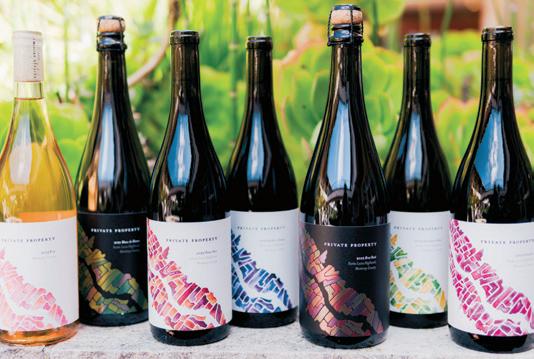
“There is always an opportunity when you are looking for it,” he says. “In fact, we have 40,000 acres of opportunity in Monterey County!”
He looks specifically for hand-harvested vineyards, most of which are SIP Certified and organic, like Highlands Ranch, where Kirk Williams farms beautiful Chardonnay Caraccioli knew would make dynamite sparkling.
“The juice was like amped up lemonade,” he says.
Williams, who also sells grapes to Odonata Winery, is eager to work with trusted winemakers like Caraccioli, and proud to have his Highlands Ranch fruit showcased by the new brand.
“There’s a fun and inviting ‘grapeness’ to Private Property,” he says. “More like a paperback than a leatherbound classic.”
The brightly colored labels, color-coded to reflect the personality and composition of the wines in the bottle, channel that liberty.
“I’m giving people access to a different set of wines in a more youthful, fresher style,” Caraccioli says. “It gives people more choice.”
Mike Kohne of Crave Wine Co. is among those who have observed Caraccioli since its beginning, and sounds energized by the new chapter.
“The Caraccioli family’s commitment to producing stellar sparkling wines has been evident since their inaugural release,” Kohne says. “Now, across the portfolio, the Caraccioli and Private Property wines continue to inspire—and elevate—an entire winegrowing region.”
Laura Ness is an award-winning journalist who writes about wine, food and travel for a variety of publications on the Central Coast and beyond.




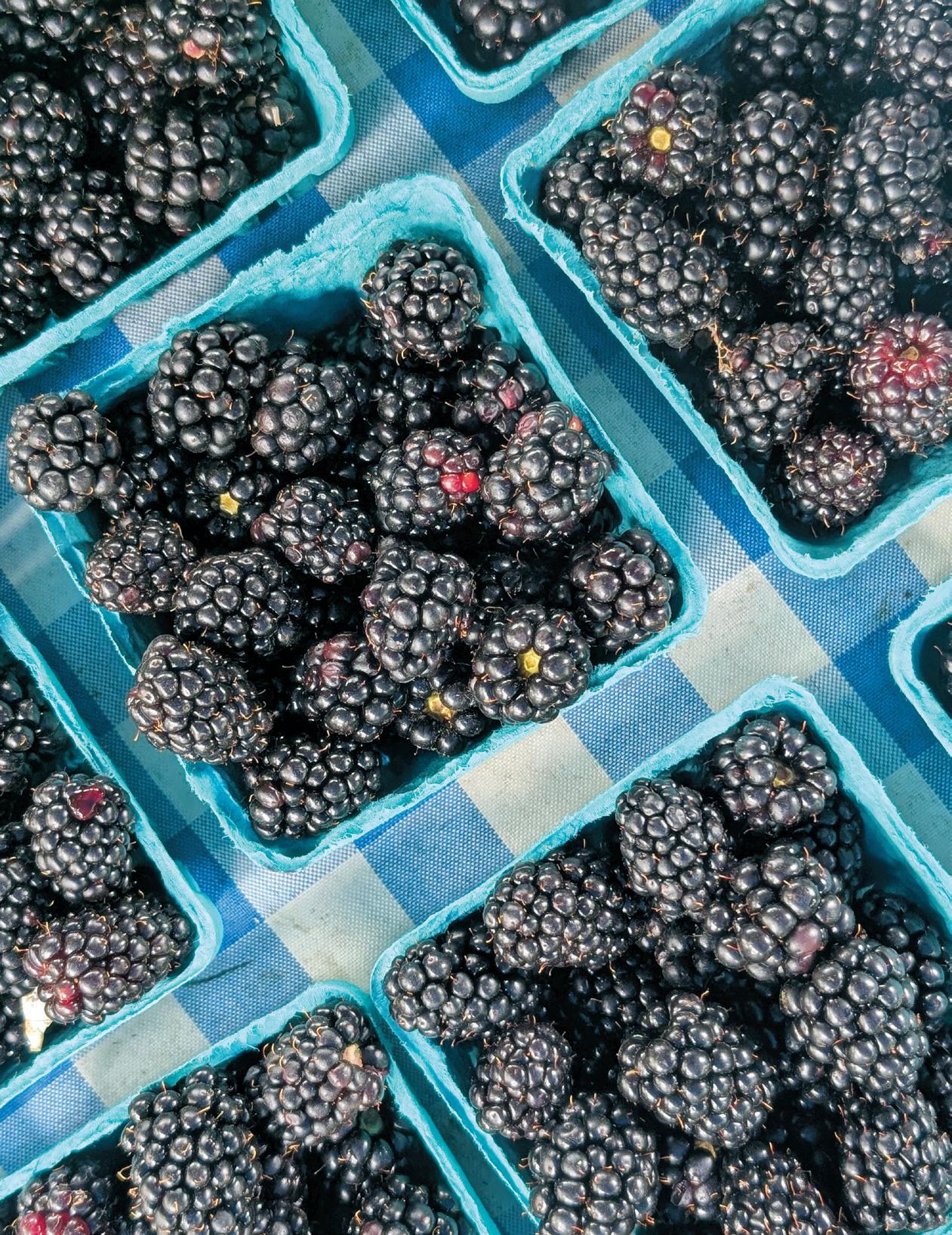
STORY BY JAMIE COLLINS
PHOTOGRAPHY BY KELLY ROSE EVANS
ummer-ripened blackberries direct from the farmers market belong in a different league than those picked under-ripe and shipped to appear in plastic on grocery store shelves.
The main focus in breeding varieties that must travel long distances is to produce fruit that is large, looks pretty and doesn’t break down quickly, so it can last several weeks before being consumed.
It can’t compare to a tender, ripe and sweet blackberry harvested in the sun and sold within a day.
Prevedelli Farms, a family run—since 1945!—certified organic operation in Watsonville, specializes in just that.
They cultivate five acres of delectable blackberries and blackberry cultivars including olallieberries, boysenberries and loganberries, harvested at prime ripeness.
Prevedelli, in fact, is one of the only local farms producing these blackberry crosses, partially because they are more fragile and labor intensive to manage due to their thorns and the need to trellis and tie the canes (aka their jointed and thick stems).
Newer varieties can be found thornless as primocanes, which means they have one strong cane, and need minimal trellising, which lowers labor costs.
But growing these tasty, ornery and old-school varieties is a passion worth the hassle at Prevedelli, and their cult following helps reveal why they make the effort.
Let’s get into these interesting cultivars.
Boysenberries are a hybrid between a blackberry, loganberry and raspberry. Boysenberries are very fragile, with a short shelf life, making them hard to find. They are reddish purple and juicy, with a raspberry undertone.
Blackberries put the ‘s’ in “berries.”
More specifically, they’re aggregate fruits called “drupelets,” known for their high antioxidant content, and as a good source of fiber and vitamins.
Rudolph Boysen, a Swedish immigrant living in Napa Valley, developed this berry but gave up on growing it after breaking his back in an accident. When he sold his ranch in 1927, he took his plant specimens to Coolidge Rare Plant Gardens in Altade-
na, where they could be replicated—and not be lost. In fact, Walter Knott of Knott’s Berry Farm in Southern California started successfully growing them in 1934 and he is the reason boysenberries are still around today.
His farm historically hosted a “Taste of Boysenberry Festival” that eventually evolved into an amusement park, and every spring its Boysenberry Festival continues to spotlight 75+ dishes featuring boysenberries.
As a kid living only a few miles from Knott’s Berry Farm, I remember—vividly—indulging in funnel cake with boysenberry preserves on top and drinking boysenberry juice when I would go to the park. After a Saturday night of dancing at Knott’s’ underage goth club, the boysenberry treats in the balmy summer night provided bliss.
The olallieberry is a cross between a black logan blackberry and a youngberry. A youngberry is itself a cross of three different species in the Rubus (or rose) family: raspberry, dewberry and blackberry.
Nick Prevedelli says olallieberries are his favorite and often called “the king of blackberries” because they don’t have as many seeds, and are a little more tart, with a nice balance of sweetness. Their complex flavor profile makes them multipurpose—great eaten fresh, or in pies and jams. When ripe, they are dark purple and longer than a traditional blackberry.
A loganberry, with its own elongated shapes and deep red raspberry colors, started as an accidental cross between a raspberry and blackberry by a Judge James Logan in Santa Cruz in the 1800s. This berry boasts the best of both worlds, with more raspberry flavor than blackberry, but with the size and texture of a blackberry.
May through October, Prevedelli sells delicious fresh berries directly from the family’s Watsonville farm (11am–4pm Fridays at 375 Pioneer View Road), and can be found at the local farmers markets— Del Monte Center in Monterey on Fridays, Cabrillo College in Aptos on Saturdays and Downtown Santa Cruz on Wednesdays.
Their value-added berry products are sold year-round—which include their blackberry jalapeño jam (a great component to a cheese platter or turkey sandwich), their traffic jam (a mix of all the cane berries) and their blackberry margarita mix (great as an addition to your favorite spirit or a mocktail). Their famous blackberry cobbler recipe appears on their website.

Wild blackberries were a big part of hunter-gatherer diets, including those of Native Americans, and have been eaten for centuries. Evidence to that end was found in the guts of a well-preserved woman discovered in 1835 in a Danish bog, by laborers harvesting peat. This proves that blackberries provided sustenance since at least 500 BC.
Blackberries likely originated from the Northern Hemisphere in temperate areas and spread all over the world with colonization. Planted as a multipurpose crop for edible fruits that could be made into wine, deployed to dye fabric and for use as ink—the berries, leaves and canes all create various colors of purple, pink and gray—and prevent erosion on hillsides.
The vines could be made into strong rope and they were also planted as a barrier of protection against predators and enemies as they are a force once grown into a thicket. However, blackberries do choke out native plants and can become hard to eradicate once established.
Historically blackberries were used to cure sore throat and gout, and Romans used the leaves in a tea to help with various ailments like fluid retention, menstrual pain and sore throats. Poultices from the leaves were used to treat wounds and skin issues. The blackberry root may also have been helpful for stomach ulcers and dysentery.
Blackberries are high in antioxidants due to their dark pigment, making them rich in polyphenols, which are healthy, plant-based compounds that reduce inflammation and boost immunity. Blackberries rank one of the highest in polyphenol-rich foods, making them the ultimate source of these protective compounds. They contain a high amount of vitamin C and fiber, too. Medicinally, blackberry leaves can be fermented and used as a digestive support, potentially lowering blood sugar and fighting off oxidative stress and combatting free radicals. They are also a diuretic, flushing toxins from the kidneys. If you want to make a tea out of blackberry leaves, there is no need to ferment them first, however fermenting does develop beneficial microbes like Lactobacillus and Bifidobacterium species.
Wild blackberries saved my life—or at least kept me from catastrophic injury. While riding my bike at Wilder Ranch, my tire got caught in a rut and I went tumbling off the edge of a ravine. I landed upside down, head first in a wild blackberry bramble!
Those wild blackberries prevented me from falling into the beach below and becoming seriously hurt. The vines were so strong, I used them to pull myself upright and climb back up to the top. I was scraped up from the thorns and bleeding, but grateful these invasive wild blackberries held me.
Wild blackberries grow all over this area and can be harvested for fresh eating. Their thorny branches are often intermingled with poison oak, so be aware. Blackberry fruit is green when unripe, red—and tart—when becoming ripe and best picked when sweet and black.
Nick Prevedelli (bottom right) measures ripeness as the early summer fruit starts to emerge, and as his family celebrates its commitment to organic practices. “We take immense pride in nurturing our berries with care, dedication and love, guaranteeing that they are not only flavorful but also free from harmful chemicals,” they write on the farm’s website.

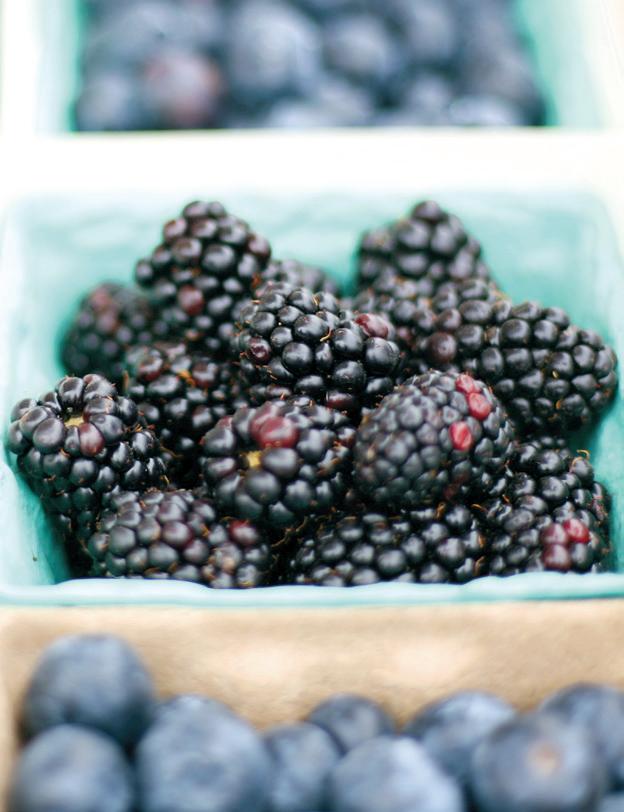
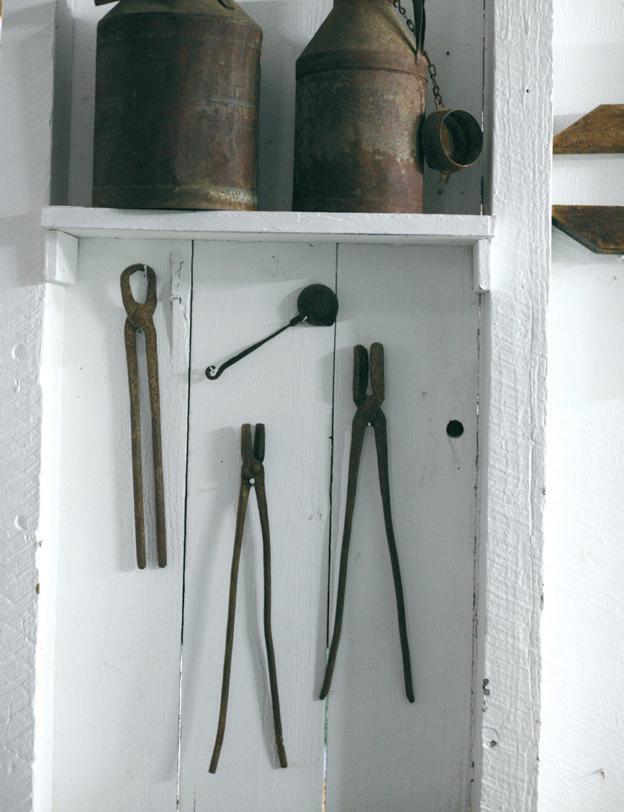

Growing these tasty, ornery and old-school varieties is a passion worth the hassle at Prevedelli, and their cult following helps reveal why they make the effort.
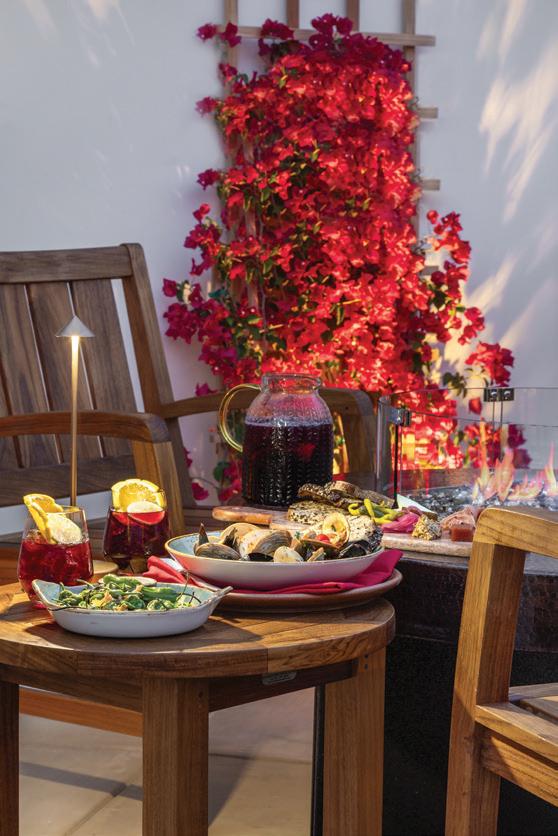
Tapas Happy Hour, 4:30–6pm
Dinner starting at 4:30pm
Brunch Saturday & Sunday 9am–1:30pm
Breakfast Monday–Friday 7–10am
Pet-Friendly Patio
Reservations Recommended
Adjacent to the Casa Munras Garden Hotel & Spa
700 Munras Avenue, Monterey 831-375-0176
estebanrestaurant.com
Blackberries can spread like their wild cousins, so be careful where you plant them in your garden. Personally, I would keep them in wine barrels or large pots to keep them contained. They need full sun and like soil to be moist, but well-drained. Blackberries enjoy a slightly acidic soil and do well with the addition of compost and a fertilizer that has an equal mix of nitrogen, potassium and phosphorus. You will need to stake them to help them grow upright, or plant them next to something they can lean on for support.
Blackberries also won’t fruit until the second year. Once they are finished fruiting, it is important to prune them back so they can regrow and fruit again. Birds are the biggest problem in cane berries; Prevedelli Farms uses plastic hawks and silver steamers that move in the wind to deter birds. However, birds still eat about 10% of the crop if it isn’t netted. Keeping bees or encouraging them where you are growing cane berries will help them set more fruit.
Spotted-wing drosophila can be a major pest in blackberries and blackberry cultivars. They are fruit flies that lay eggs under the skin of the fresh fruit. The larvae hatch in the fruit and the fruit ends up decaying rapidly. One way to control this pest is to harvest ripe fruit consistently and do not leave fruit to get over-ripe or rot nearby.
If you don’t want to grow your own, Live Earth Farm in Watsonville has a seasonal, organic blackberry u-pick. Check their website for updates, liveearthfarm.net.
If you do pick up blackberries that are not yet soft and ready to eat, I suggest keeping them on your kitchen counter and letting them ripen, and eating the ones that are a bit soft first while letting the others take time to sweeten up.
Savory preparations with berries are some of my favorites.
I really enjoy putting blackberries in a salad along with some red onion and feta or soft goat cheese, and some steak or tri-tip. Toss a few blackberries in the blender with some olive oil and a balsamic reduction to pour over the salad.
Reducing blackberries with herbs like rosemary and thyme and a little sugar can make a really great addition to meat dishes like pork chops, pulled pork sliders and roasted chicken. How about adding them to a brie grilled cheese, or topping a homemade pizza with blackberries, ricotta cheese and basil?
Be sure to get to the farmers market this summer to support your local growers and load up on local blackberries before they are gone, which happens faster than I’d wish.
Jamie Collins has been on the forefront of the sustainable farming scene for the past 25 years, operating Serendipity Farms. Her passion is educating eaters about what it takes to get good food to family tables and supporting fellow farmers.
The magic of this recipe lies in its versatility. Maybe you’ve got meat on the grill. Great—this brightens and deepens the experience. Perhaps you’re thinking of a fresh seasonal take on a mocktail or a mojito. Or you simply need to spice up some chicken. Either way, you’re equipped by building off the base in your chosen direction.
Base recipe for savory applications:
¼ cup balsamic vinegar
3 tablespoons coconut aminos
¼ cup brown sugar
½ cup tomato paste
1 whole chipotle pepper
1 small can of hatch chilis or one roasted poblano
8 ounces fresh blackberries
3 cloves crushed garlic
¼ teaspoon cumin
1 tablespoon fresh minced ginger
1 tablespoon fresh thyme
Salt to taste
Make the sauce by combining the ingredients in a blender with 3/4 of the blackberries. Blend until blackberries are smooth.
Heat in a saucepan over medium for 10 minutes, stirring occasionally. Pop the remaining blackberries into the pan and cook for 3 more minutes or until mixture thickens a little. Allow to cool somewhat before using. Salt to taste.
For cocktail mixer:
1/3 cup high quality balsamic vinegar
3 tablespoons coconut aminos
1/3 cup brown sugar
16 ounces fresh blackberries
3 tablespoons fresh minced ginger
3 tablespoons fresh thyme
Salt to taste
Make the sauce by combining the ingredients in a blender with 3/4 of the blackberries. Blend until blackberries are smooth.
Heat in a saucepan over medium for 10 minutes, stirring occasionally. Simmer on low until slightly reduced, about 10 minutes more. Pop the remaining blackberries into the pan and cook for 3 more minutes. Allow to cool somewhat before using. Salt to taste.
For hot sauce:
To turn this mixture into a hot sauce, remove the thyme, ginger and cumin, then add 1 whole chipotle pepper or a spicy pepper of your choosing, blend and cook down.







Congo Go! popularity soars with a mix of Cambodian food, fresh boba and sublime baked goods
STORY BY MARK C. ANDERSON
PHOTOGRAPHY BY KELLY ROSE EVANS
At one of the more surprising new restaurants to debut locally in the last two years, Bea Kun oversees service while her big sister and trained chef Thea Kun runs the kitchen.
Or as Thea says, “She’s like the ballerina in the front and I’m the pirate in the back.”
Bea offers another description of their dynamic.
“We have a twin-like telepathy thing,” she says. “She doesn’t have to tell me what we need, I’m just on it, and it goes vice versa.”
The siblings have been cooking together since they were little, plucking mint leaves, sorting bean sprouts, wrapping egg rolls, and skewering beef and chicken satay for their mom, who would lay out huge spreads for their church congregation in Stockton, California.
Thea describes feeding friends as fundamental to their Cambodian heritage.
“Food is our staple,” Thea says. “It’s how we bring people together. You have to have food at a function, or it’s a flop.”
Also inseparable from their history is the trauma of The Killing

Fields, which their parents carry and make sure their daughters reflect upon. Escaping genocide brought the refugee family first to Georgia, then to California.
“It’s an open wound,” Thea says. “They faced execution, saw their family killed, our grandfather killed, babies thrown [out]. The message is, ‘You better not take this life in America for granted.’ Our parents never let us forget where we came from.”
When Thea stalled professionally post-high school, working a dead end job in a pharmaceutical warehouse, she remembers thinking, “You’re not doing what you’re meant to do.”
That launched her along an arc that’s traversed struggle (“They whooped my ass at culinary school”), 17 years of restaurant work (starting in Stockton, then Sacramento and Lodi, among other places) and popularity as one of the creative forces behind The Pocket’s rise in Carmel-by-the-Sea (turning it into a locals’ and industry favorite).
Thea calls the sisters’ time at The Pocket together, honing their front- and back-of-the-house chemistry, “our last test.”

Now you can make a case that Congo Go!, while only 15 months in as this publishes, presents three separate—and excellent—identities in one place.
There’s the savory food they grew up with, executed with precision and carefully sourced ingredients, including red curry soup, Lao sausage rice and “Kathiew” Cambodian-style beef phó.
There’s the ambitious boba program that nods to their Stockton upbringing (boba was everywhere) and Bea’s sommelier training (she identifies aromas and complementary fresh fruit notes most mortals do not).
The pastry program at Congo Go!, meanwhile, rivals that of any comparable restaurant.
The banh mi loaves are hand made and baked in house. The mochi donuts, fried to order, merit a plaque on adjacent Broadway Avenue/Obama Way. The Dubai chocolate bars—a genre popularized by a viral social media frenzy—have proven so habit-forming, the price is up to $16 each (for now) and customers can only buy two maximum.
Since the bread takes a day to make (and Thea is protective of the recipe), here Congo Go! shares a simplified take on the chocolate bars that sell out with the dependability of the tides, plus two recipes for items that sound intimidating to make, but actually— per Thea—are quite manageable at home.
Which, for the Kun sisters, is where this all started.
C. Anderson is Edible Monterey Bay’s managing editor.


Thea Kun (center right, with husband David Teng, sister Bea and brother-inlaw Frank Rebultan) says culinary school taught her technique, science and the importance of ingredients. “I didn’t realize how bad sourcing at a lot of restaurants was,” she says. “You learn to eat right.” Kun’s carefully assembled Dubai bar appears top right.
Call this recipe “Dubai for Dummies.” Chef Thea Kun isn’t ready to give up her recipe completely, but does share the beginner’s version. On a related note, her husband—who like her brother-in-law is vigilant in providing support in the restaurant—drives to San Jose for the feathery pistachio filling. So you might just be better off buying Congo Go!’s bars, when they’re not sold out.
1 cup kunafa (shredded phyllo dough)
2 cups semisweet chocolate chips
¼ cup powdered sugar
½ cup vegetable oil
½ cup pistachio paste or cream
¼ cup tahini
Toast the kunafa in the oven on a baking sheet at 350° F until golden brown, approximately 10–15 minutes. Set aside.
Melt semisweet chocolate in the microwave for 20 seconds then stir and set aside.
Using the Dubai chocolate bar mold of your choice, 9x4-inches in size, spoon and evenly spread a thin layer of melted chocolate in the mold. Once coated, place mold in the freezer to harden.
Meanwhile, place the toasted kunafa in a bowl and add the powdered sugar, oil, pistachio cream and tahini. Mix thoroughly.
Take the mold out of the freezer and place on a flat surface. Using a spoon, spread pistachio mix evenly on the hardened chocolate, leveling it off just below the top. Place mold in the freezer for 5 minutes.
Once hardened, remove and place the mold on a flat surface. Pour the leftover melted chocolate on top of the pistachio mix, covering it completely, and smooth the edges.
Return mold to the freezer until bars harden, 10–15 minutes.
Carefully remove the chocolate Dubai bars from the mold and enjoy!! Serves 3–4.
Thea is direct with most things, and that holds with the inspiration to make beignets a staple. “A friend asked if I could make them, and I could,” she says. “If a customer asks for something that I can produce—and they’ll buy—consistently, I’ll make it!”
1½ cups water
2/3 cup sugar
2 teaspoons active dry yeast
2 whole eggs
1 cup heavy cream
2 teaspoons vanilla extract
6 cups bread flour
1 teaspoon salt
5 tablespoons butter, at room temperature
Powdered sugar
Mix all dry ingredients together—bread flour, yeast, salt, sugar—in a large bowl.
In a separate bowl place all wet ingredients—water, eggs, butter, vanilla extract, heavy cream—and whisk until mixed.
Combine all ingredients together and mix with your hands for 3 minutes. A wet dough forms.
Cover bowl with plastic wrap, airtight, and let sit out for 2 hours. Dough will rise fast at room temperature.
Uncover dough and gently place on a floured surface.
Roll dough with a pin roller into equal-size pieces, ¼-inch thick and 2 inches long. Set aside on a flour-dusted surface.
Choose a high heat oil and fill a pot with enough depth to submerge the dough. Place on medium high heat.
Carefully place the dough pieces in the hot oil. Let them cook until one side is golden brown, flip and let the other side cook until golden brown.
Remove the fried beignets and place on a flat sheet. While still hot, use a strainer to dust beignets with powdered sugar. Set aside.
Once cool, enjoy! Serves 7.

BONUS: A formula for homemade boba, via a surprisingly easy recipe for all.
ediblemontereybay.com/boba
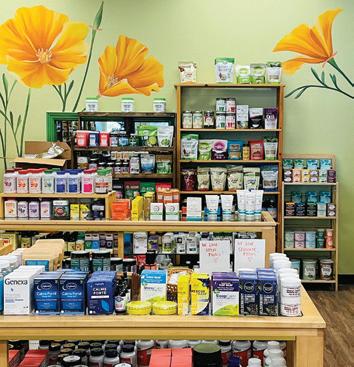
Senior Discount Mondays 10% off purchases
The only locally-owned natural food store in Aptos & Seascape

Opens at 8am daily Natural Foods • Organic Produce Supplements • Wellness Local Products • Gifts Bulk Foods • Herbs • Teas • Wine
Foods 7506 Soquel Drive, Aptos 831-621-6748

*Apples • ****Apricots • Avocados • Blackberries • ****Blueberries
*Boysenberries • Cactus Pears • **Cherries • Figs • ***Grapes • Lemons
**Loquats • ***Melons • Nectarines • Olallieberries • Oranges • Peaches
***Pears • Plums • Raspberries • Strawberries • Tayberries
**Artichokes • Arugula • **Asparagus • Basil • Beets • Bok Choy • Broccoli
Cabbage • Cardoons • Carrots • Cauliflower • Celeriac • Celery • Chard
Chicory • Collards • Corn • Cress • Cucumber • Dandelion • Eggplant • Endive Fava Beans • Fennel • Garlic • Green Beans • Kale • Leeks • Lettuces
Mushrooms • Mustard Greens • Onions • Pea Greens • Peas • ***Peppers, Bell
Potatoes • Radishes • Spinach • Summer Squash • Tomatoes • Turnips
Abalone • Halibut, California • Lingcod • Rock Cod (aka Snapper, Rockfish) Sablefish (aka Black Cod) • Salmon, Chinook/King • Seabass, White Squid, Market • Sole (Dover, Petrale) • Spot Prawns • Tuna (Albacore)
*Comes into season in June **Ends in June ***Comes into season in July ****Comes into season in August *****Goes out of season in July
All fish listed are rated “Best Choice” or “Good Alternative” by the Monterey Bay Aquarium’s Seafood Watch program and are found in abundance in local waters. See seafoodwatch.org for more information.
" I'm a fan of Sandbar for two main reasons: their strong community involvement and their dedication to quality work."
“All while maintaining transparency and honesty from start to finish during the solar process." -Tyler Fox (shown here)







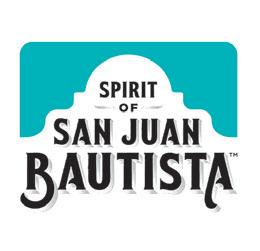
























These past few months have taught us all many things, for better or worse.
And it seems that a key takeaway, amidst all the chaos, is that eating local is a great idea.
We are fortunate to have so many ingredients right here, fresh and ready to enjoy, for the price that our local farmers have hopefully set for us in the face of a quaking industrial economy.
Tuesday
Felton Farmers Market
1:30−5:30pm • May through October 120 Russell Ave. 831.454.0566 santacruzfarmersmarket.org
El Mercado
2−6pm • April through October Crestview Drive and Madison Street Watsonville 831.726.4257 • pvhealthtrust.org
Wednesd ay
Downtown Santa Cruz Farmers Market
1pm-5pm • Year-round Lincoln and Cedar Streets • 831.454.0566 santacruzfarmersmarket.org

Friday
Why yes, I’d love to purchase that heirloom tomato from you, maybe a mile from where it was grown, confident in the suitable hue and texture that nature’s rhythms decided was best, not the harvesting machine and a semi-truck or freighter ship.

Let’s not forget how lucky we are to have abundant, delicious local food.
And please support those who are growing it for us.

Watsonville Certified Farmers Market
2–7pm • Year-round
Watsonville City Plaza, Peck & Main Streets 831.588.7366 facebook.com/watsonvillefarmersmarket
Mountain Farmers’ Market
2:30-6:30pm • May to October 23845 Summit Rd, Los Gatos mountainmarket2024@gmail.com www.instagram.com/mountain_market
Saturd ay
Aptos Certified Farmers Market
8am–Noon • Year-round 6500 Soquel Drive • 831.728.5060 montereybayfarmers.org
Westside Santa Cruz Market
9am–1pm • Year-round 2801 Mission Street • 831.454.0566 santacruzfarmersmarket.org
Scotts Valley Farmers Market
9am-1pm • May through November 5060 Scotts Valley Drive, Boys & Girls Club Parking Lot 831.454.0566
santacruzfarmersmarket.org
Sunday
Live Oak Farmers Market
9am–1pm • Year-round 15th and East Cliff Drive • 831.454.0566 santacruzfarmersmarket.org
Corralitos Farm & Garden Market
11am–3pm • Year-round 127 Hames Road • 831.724.1332 wayne@catalyst2001.com https://www.instagram.com/corralitosfarmandgardenmarket/
Monday
Pacific Grove Certified Farmers Market
3–7pm • Year-round
Central and Grand Avenues
831.384.6961 everyonesharvest.org
Tuesday
Carmel Barnyard
Certified Farmers Market
9am−1pm • May through September 3690 The Barnyard 831.728.5060 • montereybayfarmers.org
Old Monterey Marketplace & Farmers Market
4–7pm • Year-round Alvarado Street • 831.655.2607 oldmonterey.org
Wednesday
Natividad Certified Farmers Market
10am−2:30pm • April to October 1441 Constitution Blvd., Salinas 831.384.6961 • everyonesharvest.org
Hollister Certified Farmers Market
3−7pm • April to October San Benito Street between 5th and 7th 831.636.8406 downtownhollister.org/farmers-market
Thursday
Carmel–by-the-Sea Farmers Market
10am–2pm • Year-round 6th and Mission Streets 831.402.3870 • goodrootsevents.com
Castroville Farmers Market
32−7pm • Year-round Castroville Recreation Center 11261 Crane Street ncrpd.org
Seaside Certified Farmers Market
3–7pm • Year-round Laguna Grande Regional Park 1259 Canyon del Rey Blvd. 831.384.6961 • everyonesharvest.org
Soledad Certified Farmers Market
4−8pm • April to October 137 Soledad St. • 831.678.3504
Friday
Monterey Certified Farmers Market
8am–noon • Year-round 1410 Del Monte Center 831.728.5060 • montereybayfarmers.org
Salinas Valley Memorial Certified Farmers Market
11:30am-4:30pm • May 9 to November 7
450 E. Romie Lane, Salinas 831.384.6961 • everyonesharvest.org
Saturday
Old Town Salinas Farmers Market
9am–2pm • Year-round
300 block Main Street
650.815.8760 wcfma.org/salinas
Sunday
Carmel Valley Certified Farmers Market
10am–2pm • Year-round Mid-Valley Shopping Center 550 Carmel Valley Road 650.290.3549 • wcfma.org
Marina Certified Farmers Market
10am–2pm • Year-round 215 Reservation Road • 831.384.6961 everyonesharvest.org



















August 1 - September 30, 2025






America’s Farmers Market Celebration™ (AFMC) is the only annual ranking of the top farmers markets in the United States as voted on by the public. Since 2008, the AFMC has highlighted the important role farmers markets play in communities across the nation while celebrating the farmers, staff, and volunteers who make markets happen.





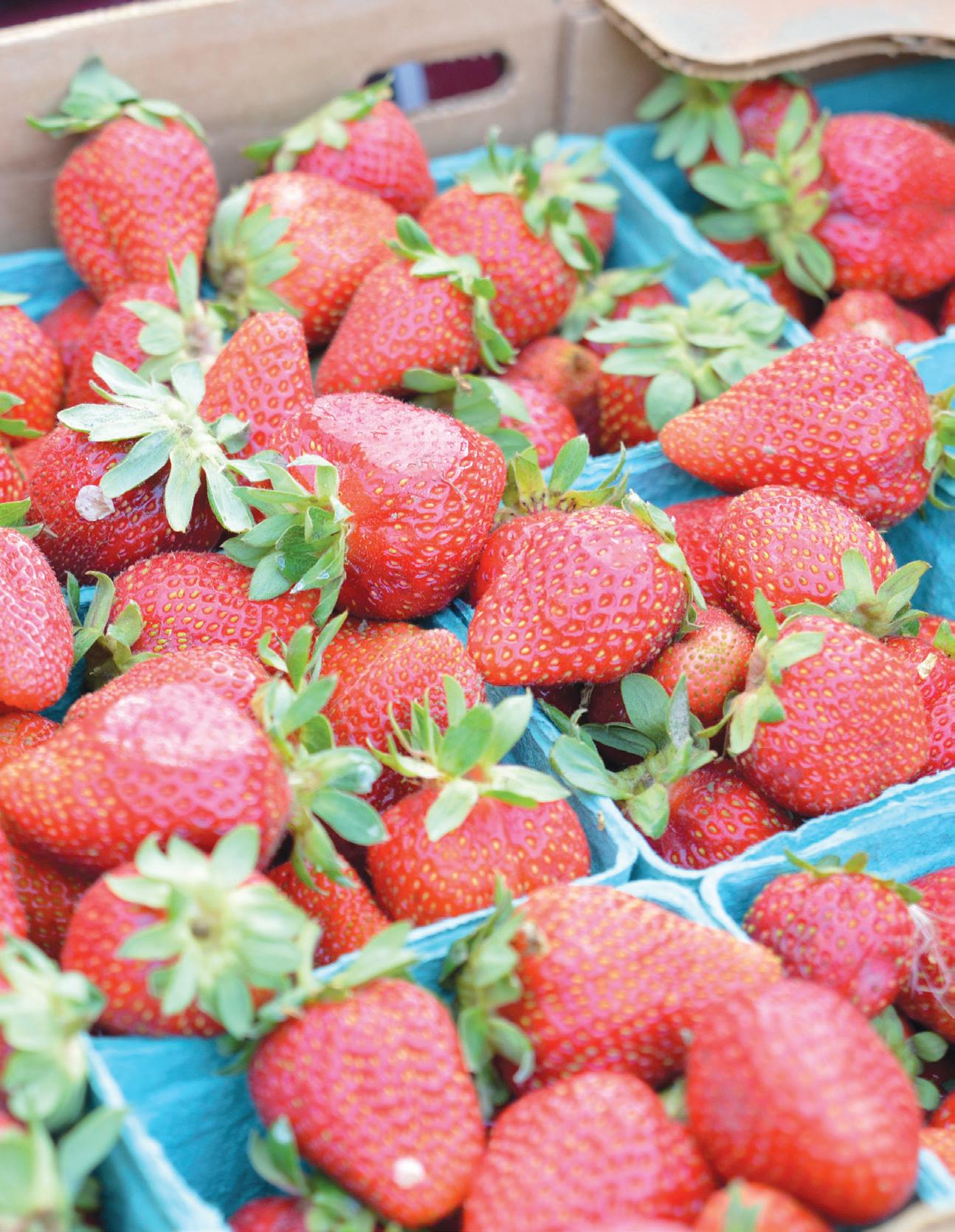
Identity and complexity resonate in a glorious chilled soup

azpacho is all about the tomatoes, and their ability to channel sunshine and a summer breeze in one juicy bite.
Well, not entirely.
It’s also about the discovery of a dish you suddenly can’t get enough of.
It’s about tasting several vegetables in balanced unison.
It’s about identity, making the best of what the land near you yields, and exploration.
It’s about history, memory and context.
And—nostalgia aside—cooking gazpacho is about finding connections where they didn’t seem to exist.
aGazpacho as a concept is certainly ancient.
When the Spanish peninsula was a Roman province, gazpacho’s ancestor salmorium—garlic pounded into a paste with bread, vinegar and oil—nourished field workers.
By the 16th century, tomatoes sailed from the New World and sunny southern Spain’s warm weather allowed them to flourish. Combined with the centuries-old salmorium, the result was gazpacho Andaluz, the widely known and beloved cold summer soup, distinguished by its smooth texture and refreshing taste.
There are multiple regional interpretations, forming a whole gastronomic gazpacho map. You can tell a lot
PATRICK TREGENZA
by which type of gazpacho someone likes, or which their grandma made.
Salmorejo, also from Andalusia, provides a heartier version, with grated or roughly chopped ingredients, garnished with hard boiled egg and serrano ham. From neighboring Extremadura, “campero” or “extremeño” gazpacho omits tomatoes.
Ajo blanco is the primeval recipe present in regions with strong Arab influences—not one for mild flavor fans, thanks to layers of garlic, almonds, vinegar and olive oil— with floating green grapes serving as the obligatory garnish. Without the grapes it works as a light mayonnaise, perfect for lobster and shrimp or with a collection of fresh herbs. And the garlic intensity can be tamed by blanching in water before blending.
A close relative from Málaga, gazpachuelo, has the same base, warmed up as a brothy background for seafood and potatoes with the addition of egg yolks. A more distant cousin from central Spain, gazpacho Manchego, feels like the complete opposite, a game stew topped by old bread.
Some recipes for gazpacho Andaluz start by mentioning you absolutely must grow your own tomatoes.
Yes, that might sound extreme, but people are really serious about their gazpacho. (And less strict versions ask that you let your farmers market haul sit gently in the windowsill where it gets morning sunlight.)

Yes, that might sound extreme, but people are serious about their gazpacho.
Either way, you certainly need to have sweet, juicy, aromatic, summer-ripe tomatoes as the base.
Cucumbers are also crucial, as are garlic and bell peppers, red or green, depending on preference. Bread, although not essential, provides a binding, uniform, almost creamy consistency. This is not the moment to use crusty sourdough as it might show up as dark speckles in the result.
Sherry vinegar and the best olive oil you can get your hands on are also critical. Seasoning is normally only salt, although some souls from Sevilla swear by a pinch of cumin.
Occasionally recipes suggest roughly chopping the ingredients and allowing them to marinate with salt. It doesn’t make a significant difference. The step that really matters is to blend it for longer than you would consider normal, and then strain it, turning it into a velvety delight.
Refrigerating gazpacho before serving, meanwhile, is non-negotiable. You can even throw ice cubes in the blender to make sure nothing heats up.
Serve in bowls or glasses—though there is always the option of drinking gazpacho straight from the pitcher while at the refrigerator door.
That’s what the protagonists did in Pedro Almodóvar’s Women on the Verge of a Nervous Breakdown. Sharing it symbolized a connection of identity, allowed them to set differences and stress aside, and opened a discussion on the subtle quirks that make us—and how we make our gazpacho—special. It was also laced.
And then there are of course the garnishes, or “tropezones” that translates to “things you would stumble upon.” Toppers can include cubed pepper, cucumber, tomato, hardboiled egg and serrano ham.
From there, consider gazpacho an impeccable canvas for seafood, cooked or canned, even tuna tartare. Serving it as the base of a layered crab or shrimp salad is always a success. Fresh goat, feta and other cheeses can take flavors in a different direction.
Going back a few decades, Spanish chefs like Juan Mari Arzak and Ferran Adrià began a strong creative movement with a fresh look at regional ingredients and seasons. Welcome additions to the classic started appearing on menus.

Successful combinations with the tomato base include strawberries, cherries, peaches, watermelon, beets, cantaloupe and raspberries. Leaving the tomato behind, green versions with grapes, peas, avocado and even mango are wonderful. There is also the possibility to experiment with textures, going from silky with a high thread count to roughly chopped.
If there is a recipe that reads like sheet music for jazz improvisation, it is definitively gazpacho. The lines between sweet and savory; soup, salad or sauce; smooth or textured; and even traditional or novel are all meant to be broken.
Draw a new line with what you are and love.
Analuisa Béjar loves exploring flavor as the chef at her Sunny Bakery Cafe in Carmel Valley. A native of Mexico City, she’s gone on to become an award-winning writer, editor, food critic, recipe developer and culinary teacher.
This is a traditional version that serves as a great guideline. Although onion is sometimes included, it can be overpowering. This base is perfect for further experimenting.
1 pound ripe tomatoes
½ pound cucumbers, peeled and seeded
1 small red bell pepper, seeded
1 small clove garlic, peeled
1/3 cup extra virgin olive oil
4 tablespoons sherry vinegar
3 ounces day old bread
½ cup water
Salt to taste
Ganishes, or tropezones (optional): cubed cucumber, bell pepper, fried bread croutons, serrano ham, cucumber ribbons, cherry tomato, olive oil
Remove stems from tomatoes and cut in half.
Place in a blender with remaining ingredients and purée on high for at least 3 minutes or until you have a smooth consistency; you may add more water if necessary.
Pass through a sieve and refrigerate until serving. Garnish to taste. Gazpacho can be refrigerated for up to 4 days. Serves 4.





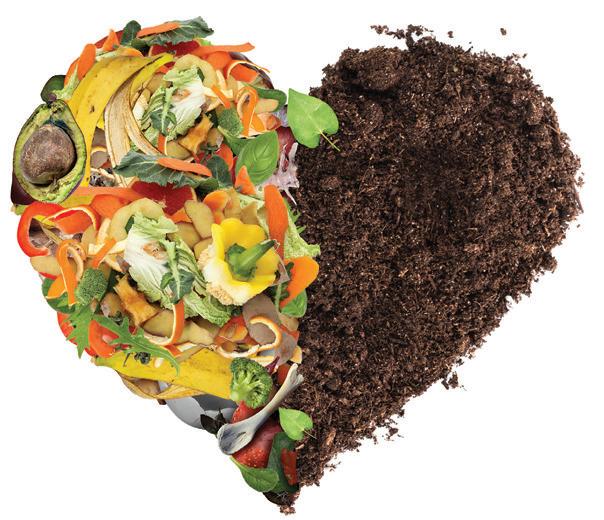



Gazpacho makes a perfect sauce for seafood, or in this case, burrata. Serve it with grilled crusty bread for a light lunch. If you’d like to prepare it ahead of time, add ½ a cup of labneh or Mediterranean yogurt to prevent discoloration.
2 avocados, peeled and pitted
1 cucumber, peeled and seeded
1 small green bell pepper, seeds and veins removed
1 small clove garlic
½ cup fresh basil leaves
Juice of 1 lime
½ cup extra virgin olive oil
Pinch of ground cumin (optional)
Salt
Garnishes (optional): burrata, mango ribbons, pumpkin seeds, fresh herbs, edible flowers, Aleppo pepper, olive oil
Place avocados, cucumber, bell pepper, garlic, basil, lime juice and olive oil in a blender jar or food processor.
Purée until combined but with a rough texture. Season with salt to taste.
Serve in a bowl with burrata and decorate with remaining ingredients.
Serves 2.
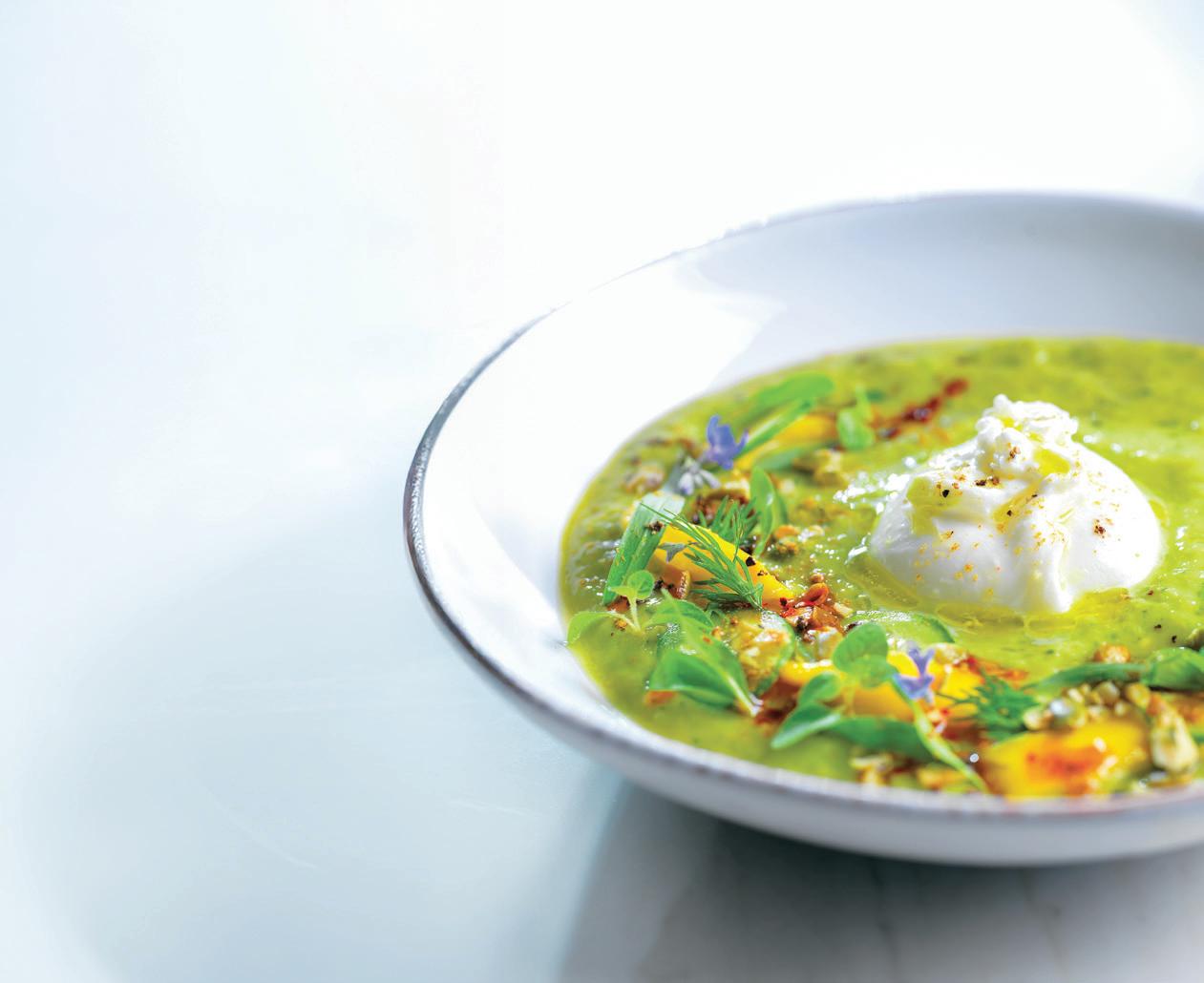

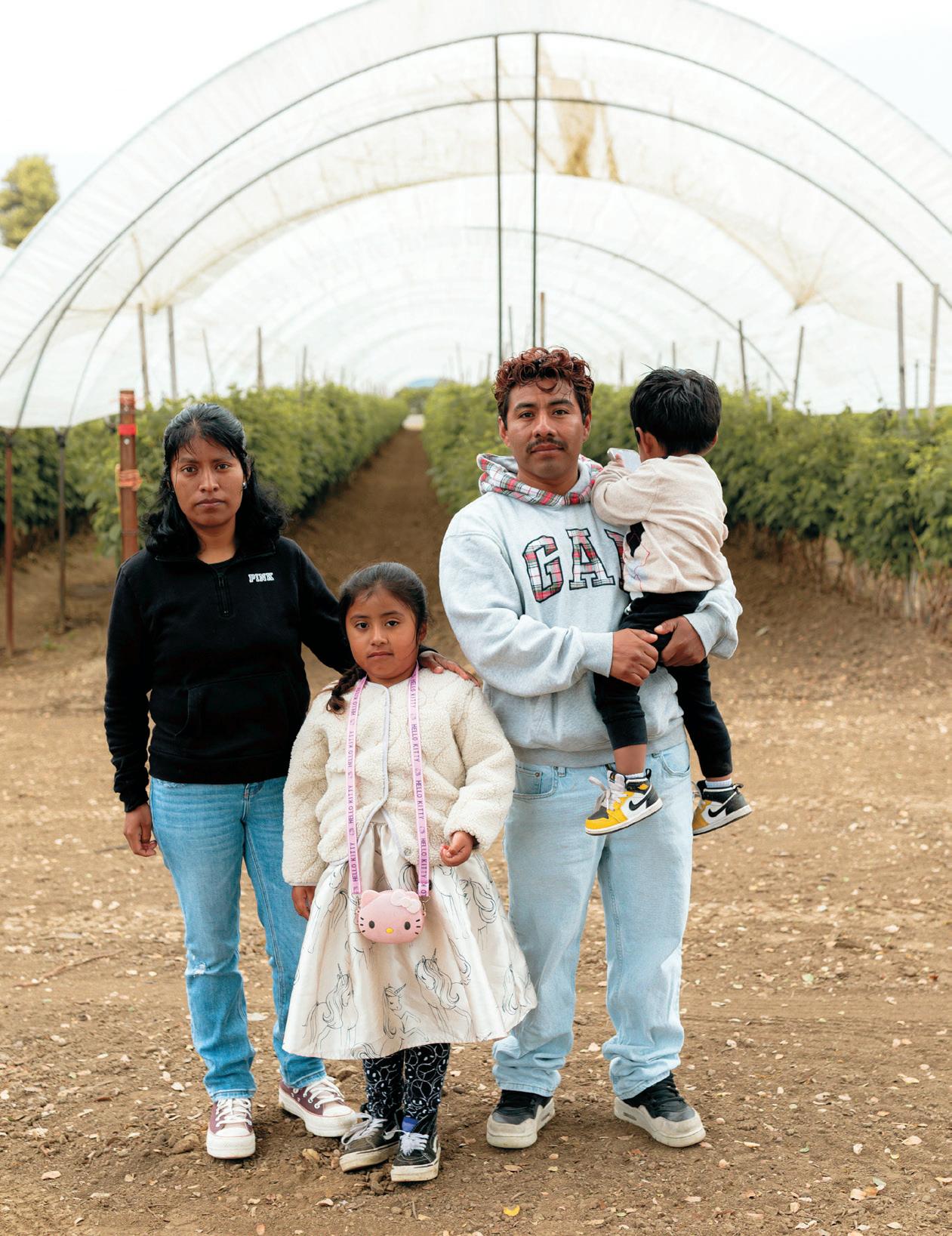
STORY BY MARK C. ANDERSON PHOTOGRAPHY BY GENEVA RICO
Dolores Huerta stands at a temporary podium on a dirt road in Watsonville, with a farm treated with pesticides on one side, and MacQuiddy Elementary School on the other.
You’d think the juxtaposition would be enough to inspire action, given the links between childhood cancer and chemicals used at the farm, including chloropicrin, malathion and 1,3-dichloropropene.
If that isn't enough, there’s also the fact Huerta, the 5-foot-tall giant in the United Farm Workers (UFW) movement, still has this self-evident problem to call out.
The moment comes a half century after she launched UFW with Cesar Chavez, and a month after she celebrated her 95th birthday.
“There is no reason [growers] have to use pesticides,” she says. “Organic farmers have proven that you can grow food without it for centuries.”
The gap in reasoning is familiar to the woman who introduced Huerta at the rally, Dr. Ann Lopez.
As Lopez likes to say, “If you’re looking for logic, you’re in the wrong place.”
their financial, physical and overall well-being.
Its avenues to do so include furnishing emergency supplies, rental assistance and educational programs that channel everything from digital literacy to legal rights.
At a Capitola Branch Library lecture this spring, the audience can hear the strain in her voice as she lays out what she calls the “context” for farmworker abuse, namely deregulation, privatization and blaming the poor.

For decades, Lopez has directed the nonprofit Center for Farmworker Families (CFF). In the weeks after the rally, she will leverage a milestone birthday of her own (her 80th) for more support of its efforts.
Before Dolores Huerta (right) spoke, former strawberry harvester Gia (far left, with her family) took the podium to describe how working in non-organic fields likely contributed, per her doctor, to cancer in her stomach that led to its removal.
CFF’s cause involves creating awareness of the circumstances farmworker families face, and working to enhance
“It’s basically a whole life of deficiency—not enough for food, clothing, housing, education,” she says. “It’s a caste system.”
You can hear the ache as she ticks off the confounding cruelties that pile on top of a physically grueling job: long hours, short pay, extreme weather swings, harassment, exploitation, constant fear of persecution.
“We have to recognize them as human beings who are responsible for our food supply—what’s more important than that?” she asks. “It hurts my soul. They work harder than anyone. The human factor is largely absent.”
And you can feel her fury at what— despite all she’s witnessed—haunts her most.
“The most disturbing part of knowing [the farmworker community] is the incidence of anomalies in children: bone cancer, brain cancer, leukemia, autism, a whole litany of conditions that will affect them their whole life. Almost every household has one kid with an anomaly. How in the world is this allowed? These are children!”
She reiterates many of those points at the start of CCF’s regular Farmworker Reality Tours, public-facing immersions that give farmworkers the chance to be seen and heard.
And offer interested locals the opportunity to listen.



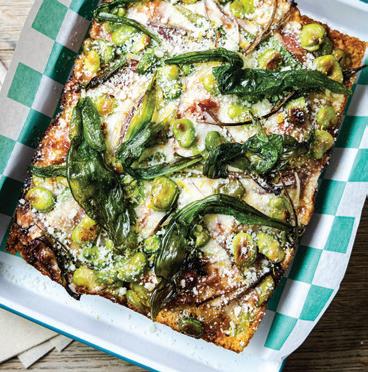


As the most recent tour starts at Crystal Bay Farm in Watsonville, a woman we’ll call Angelina starts speaking softly in Spanish.
She sits in front of the group on a wooden stool, her feet not touching the ground, and apologizes for the blunt strokes of her Spanish, as it isn't her first language. (Her native dialect is Mixtec.)
Above, MacQuiddy Elementary’s fence runs along farm roads and berry plots who deploy pesticides. Below right Enestina stands in her Watsonville kitchen, where she cooks for her youngest children. “I want farmworkers like me to have people teaching them about dangers, educating them, and letting them know they have a voice,” she says.
A bilingual tour participant, a student of UC Berkeley’s Jesuit School of Theology, volunteers to translate.
Leaving her parents in rural Oaxaca at age 14 was excruciating—“You still need them,” she says—but such was the depravity she faced.
“The dream is to have a better future, not just for me but my child,” says Angelina, now in her 20s, as her young son taps on a pumpkin by the farm’s raised beds. “I don’t want him to grow up in the same conditions.”
She methodically describes three nights on a bus followed by four nights in the desert with a human trafficker—rattlesnakes’ rattles chasing away sleep, temperature dips that freeze the water in her bottle, an onslaught of scrapes, blisters and bruises capped by collisions with needle-sharp cacti while feeling the way through a moonless night.
“Puro espina,” she says. Pure thorn.
When Angelina, her older brother and the rest of their pod were intercepted by border agents, soaked by recent rains, their limited water and bread well gone, their feeling was relief.
Her brother was so traumatized by starvation and psychosis, he returned home.

Angelina persevered, alone, joining a smothering pile of bodies in the back of a shipping truck across the border, and finding a job despite the double language barrier.
While Angelina’s tenacity reflects unique resolve, concordant refrains follow.
Three more berry workers from nearby Buena Vista Migrant Center (also speaking through the aspiring seminarian) depict wages deferred and stolen; a daughter’s wish to make enough to keep her mother from the fields; and another’s desire to complete a final season—picking from her knees now that her back can’t take it—so she can care for her mom full time.
When they’re done, Lopez notes the audience looks like they’ve “seen a ghost.”
Dr. Mary E. McGann—an associate professor at the Jesuit School of Theology attending with her students—reports she observed something incorporeal too.
“The motivation and willingness to believe in a future—and do what it takes to have it—is remarkable,” she says. “There’s so much spiritual wisdom that comes with that…we have to look at farmworkers as more than labor. They are gifts.”
“If you’re looking for logic, you’re in the wrong place.”

Ernestina’s eyes flash fierce, clear and kind.
She sits under a brawny green Japanese maple in her Watsonville backyard, which serves as both a distribution site for Center for Farmworker Families’ vital supplies, and the tour’s closing stanza, starring a meal she preps personally.
She’s had practice describing her circumstances, and making an electric salsa quemada to pour over moist and savory chicken tamales to pair with hot atole beverages.
But she still gets emotional describing them.
The reason she first came from Michoacan in 1993: a better life for her mom, who raised her without electricity, running water, blankets or enough to eat. “It was a sad poverty,” she says in Spanish.
The reason she speaks out: Campesinos need more information on resources and rights, and their voice deserves to be heard, unintimidated into accepting subhuman conditions.
“We’re not taking advantage of the system, we’re paying taxes,” she says. “We’re trying to make a change for ourselves, and we’re putting in our part working the harvest.”
The reason criminalizing migrants insults logic: “People who have education and opportunity don’t want to do this—would you?—and maybe they can’t. Because it’s hard.”
The widowed mother of four will share more of that story at the rally before Lopez and Huerta speak, including how she worked the fields while pregnant with her youngest two children, who now suffer with learning disabilities and schizophrenia.
“If I had known there were chemicals in the field,” she says, “I never would’ve worked there. My lack of knowledge, then, is carried by my children, now.”
From there she pivots to empowerment.
“I ask the farm owners to have a conscience, and think about the kids, who are our future,” she adds. “Change is possible. In unity, there is strength.”
Wendy Gabbe Day, a Santa Cruz resident, Food As Medicine event director and mother of two kids, felt the impact of the tour in real time.
“I had no idea what was happening in our own backyard,” she says. “So to hear the stories…I got chills—people doing the work, learning how they got here…the pain involved in the process…how close it all is to our homes.”
Gabbe Day was so moved she signed on to volunteer with vital supply distribution, and later became CFF’s development director.
“I wish we could introduce the tour to every college,” she says. “It’s something that will transform the way you see the world.”
Lopez often asks audiences what response they’d expect if pesticide spraying happening near schools in South Santa Cruz County was happening further north.
Gabbe Day has discussed as much with fellow parents.
“It would be crazy how noisy and infuriated Santa Cruz parents would get,” she says, “which feels so sad.”

At Café Guaraní, every empanada is handmade with love, tradition, and rich South American flavor. Enjoy gluten-free, vegan, and classic varieties, paired with our signature yerba mate or spiced mocha. Discover the heart of Paraguay in every bite.



In her position as administrative co-leader of Esperanza Community Farms’ sustainable agriculture advocacy—and a Watsonville native—Mireya Gómez-Contreras is familiar with the problems addressed by Huerta and others on that dirt road in May.
Dr. Ann Lopez (left, wishing Huerta happy birthday) says her overriding experience from working in farmworker justice boils down to visibility. “To much of society, they just don’t matter. You don’t see obituaries. The goal, often, is to make money at any cost, and to get rid of the law, not the pesticide.”
She also feels it’s mislabeled. Conventional, the adjective used to describe farming that uses pesticides, doesn’t do prevailing practices justice.
“Let’s be truthful,’” she encourages the crowd. “Let’s say, ‘This [non-organic] strawberry is made with poison,’ and ‘I’m not going to eat strawberries made with poison.’”
Gómez-Contreras observes other unhelpful perspectives when it comes to confronting the problem.
“Let’s not talk about how hard it is but how to get there,” she says. “Half of the solution is focusing on the solution.”
She draws from UC Santa Cruz sociology training to help identify patterns across ag sectors, and specifically “pockets of organic farming that are flourishing.”
Thankfully, the list of local organic producers is long, as Adam Scow of the Campaign for Organic & Regenerative Agriculture attests.
“Organic is a model that’s working, and thriving,” he says.
At the rally, Scow calls for Driscoll’s Berries to go organic in the Pajaro Valley, or at least be thoughtful about where its toxic treatments spread.
“What we’re asking for is very modest,” he says. “Our dream is a valley farmed naturally, but what we’re looking at first are plots close to schools,” which number at least a dozen.
He zooms out to tout Driscoll’s potential impact with relatively small local measures, given its global presence in half a dozen countries and $5 billion in annual revenue.
“It’s a reasonable request, considering small independent farmers with slimmer profit margins and more risk have done it,” he says. “Given their distribution network selling to major retailers around the world, if anyone could afford to do it, it’s Driscoll’s.”
"The motivation and willingness to believe in a future—and do what it takes to have it—is remarkable.”
Calls to boycott the biggest berry grower in the region cascade through the rally.
For their part, Watsonville-headquartered Driscoll’s—which, full disclosure, is an Edible advertiser that spotlights its organic division—wasn’t able to connect me with a rep to speak before this issue’s deadline.
A Driscoll’s board member instead directs me to their web page titled, “Driscoll’s Commitment to the Pajaro Valley.”
The statement reads, in part: “Advances take time, research, and investment. But we are committed to leading the way toward more sustainable farming practices. We continue to engage with our independent growers about land management practices that include options to transition some fields into organic production.”
Gómez-Contreras anticipated the reply at the rally—“We keep hearing, ‘It’s too expensive, it’s too difficult,’ but that’s the work, right?”
Cut to Cesar E. Chavez Middle School in Watsonville, at Career Day last March.
Gómez-Contreras speaks with a class of fifth graders, explaining
how she loves having a job that— however difficult—affords the chance to confront social problems.
“We need a plan, instead of excuses,” she says later, “with our thoughts not on problems but on solutions. Let’s fall in love with those.”
At one point a woman attending the rally offered Dolores Huerta’s support crew a chair for Huerta, 95, to take a break. “She's not going to sit,” he replied quickly, “when everyone is standing.”
She didn’t expect to walk away from the classroom as moved as she was after posing a spontaneous question to the class.
The question: Who would like all-organic fruits and vegetables in the cafeteria?
The response: a raised hand from every seat in the room.
When Gómez-Contreras shares that story at the rally, one attendee shouts, “¡Los jóvenes son la esperanza!”
The kids are our hope.
A challenge embeds itself in that cry: Before the kids can save anyone, somebody has to protect them first.



Ways you can help protect human and soil health

Some seek to handcuff the hands that feed us, which can be distracting, to put it mildly. Fortunately, there are positive actions to focus on instead, listed here.
Check the map.
The fumigant 1,3-dichloropropene is banned in 34 countries. That’s one of a number of toxins the Campaign for Organic & Regenerative Agriculture (CORA) tracks with colorcoded grids, noting 1 million pounds of pesticides are applied in Santa Cruz County annually, all too often on agricultural fields near schools and homes in the Pajaro Valley.
A seven-panel infographic on CORA’s page at farmworkerfamily.org/cora spotlights the scary-close proximity, which contributes to the county having the second-highest pediatric cancer rates in the state.
Take a tour.
The homespun Center for Farmworker Families (CFF) voyage moves through organic farms and the Buena Vista Migrant Center, experiences lived and person-to-person interaction. The insight communicated proves sobering and inspiring, as recent visitor and Jesuit theology professor Dr. Mary E. McGann observes. ”The tour is empowering for those interested in what they can do to help,” she says. “It’s also moving given the incredible sense of courage and endurance the workers—all of them women—convey.”
Volunteer without fear.
CFF coordinates with Watsonville police to avoid any potential U.S. Immigration and Customs Enforcement (ICE) interference when CFF shares pantry items, detergent, diapers and food, among other items, at its monthly distribution gatherings. Volunteers are welcome to help gather and disperse goods, farmworkerfamily.org/volunteer-program.
Track the winds.
SprayDays California, launched in March 2025, is a first-of-its-kind statewide system that informs when and where restricted pesticide applications will take place, spraydays.cdpr.ca.gov.
Share stuff.
All area locals are encouraged to donate clothes, toiletries, house supplies—basically anything of use—to CFF. “Everything we receive,” one volunteer says, “we give out.”
Provide direct support.
CFF accepts tax-deductible donations.

Buy organic.
Voting no on pesticides can be as simple as buying organic. Fortunately the Monterey Bay area enjoys dozens of mindful growers like Lakeside Organic Gardens, the largest familyowned and -operated, 100% organic vegetable operation in the United States. In so doing, shoppers can honor the wisdom one old farmer shares with Edible: “Why would you want to eat something a bug wouldn’t?” he asks, adding, “or that would kill it?” CORA chief Adam Scow adds more motivation: “This isn’t just a public health threat. It’s about fumigating the soil, which kills it. We’re also fighting for the future of farming.”
—Mark C. Anderson
experience jacks monterey inside the portola hotel & spa

handcrafted cocktails & award-winning wines on the pet-friendly outdoor terrace with fire pits
seasonal cuisine from locally sourced ingredients for breakfast or dinner
in our tree-lined atrium dining room or cozy fireside bar
locals discount & complimentary self or valet parking





Tracking and testing the finest full-course salads in Monterey Bay, paired with divine hikes
STORY BY KERA ABRAHAM PHOTOGRAPHY BY HANIF PANNI
There’s nothing gourmet about a Cobb salad.
No chef is getting a James Beard Award for arranging neat sections of meat, cheese and veggies over lettuce.
Yet this basic assembly of chopped ingredients has maintained its place on American menus for nearly a century.
A Cobb is defined by its ingredients: traditionally chicken, bacon, egg, avocado, blue cheese and tomato over robust greens, dressed in a red wine vinaigrette.
Equally definitive is its presentation, with most elements finely diced and colorfully clustered.
In my quest for the finest examples in Monterey Bay, I discover why this California classic endures: It delivers reliable comfort through its winning balance of flavors and textures, providing a satisfying, nutritionally complete meal in salad form.

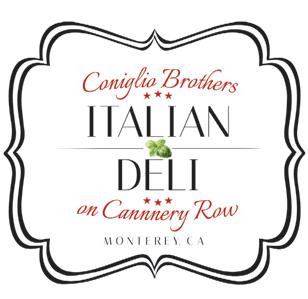
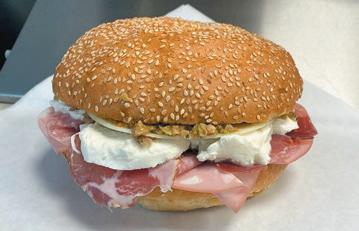
Cannery Row’s favorite deli— where every bite tells a story. From their family’s legendary Mediterranean Market to today’s beloved shop, each sandwich is a tribute to the people who shaped this legacy.
daily 10am to 5pm
Summer is peak
season in Monterey Bay, when both ingredients and parklands are at their prime.
I find myself oddly obsessed with the mission. This humble protein pile would lead me across three counties, inspiring offbeat conversations and adventures off the beaten path.
The salad’s origin traces to the 1930s when, reportedly, a hungry Bob Cobb—manager of the Brown Derby in Los Angeles—improvised with restaurant leftovers in a late-night fridge raid.
According to The Brown Derby Cookbook , four of Cobb’s pals shared his multicolored mélange.
They later requested the salad by Bob’s name. When the second Brown Derby opened, its menu featured a Cobb that became the Derby’s signature dish and spread to menus nationwide.
Credit the contrast of textures: creamy (avocado and blue cheese), crunchy (crisp bacon and lettuce) and tender (chicken, tomato and egg). Or the mingling of flavors—salty, subtly sweet, buttery and tangy—on a crisp bed of lettuce, with a bright, acidic vinaigrette tying everything together.
Then there’s the Cobb’s power to satisfy without carbs, as Executive Chef Fer nando Reyes of Carmel Valley Ranch’s Valley Kitchen points out.
“We’ve observed increasing guest de mand for high-protein options, and as sociation with dietary trends like keto has further contributed to its appeal,” he says.
Dozens of menus throughout Mon terey Bay feature Cobbs, many with the restaurant’s own twists.


One variable is the dressing.
The Brown Derby’s “Old Fashioned French”—made with red wine vinegar, oil, Worcestershire sauce and English mustard—set the standard for the red wine vinaigrette variety. Most modern Cobbs are finished with vinaigrettes or creamy blue cheeses, but I also encounter local versions tossed with Russian, green goddess or ranch.
A low-stakes swap is the lettuce: Variations on iceberg or romaine include butter lettuce and mixed greens, sometimes with flavor enhancers like watercress or chicory. The key is to choose sturdy leaves that can support the toppings and dressing.
Protein is another interpretive zone. Victoria’s Italian Deli in Hollister serves an “Italian Cobb” featuring chopped deli slices of salami, ham and turkey. At The Wild Plum in Monterey they poach rather than hard-boil the egg, at the Running Rooster in Hollister they pickle it and at Carmel Belle in Carmelby-the-Sea, they skip the egg altogether.
Still, there’s a tipping point. Too many departures from tradition, and a salad can no longer rightfully claim Cobb’s name. One local deli offers what they call a

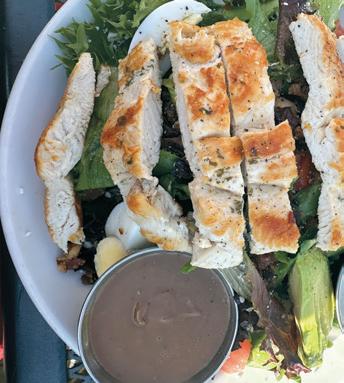
At Carmel Valley Ranch’s Valley Kitchen, the Cobb presents cherry tomatoes and hard-boiled egg cleanly halved, avocado quartered, grilled chicken breast in strips and smoky, golden-brown lardon. The decadent housemade dressing, starring Point Reyes blue cheese and crème fraîche, thinly coats a medley of small, tender lettuces.
“We take great pride in featuring our own homegrown produce, harvested directly from our property,” Reyes says.
Up the road and by-the-Sea, Carmel Belle co-owner Jeff Nelson says the Cobb is their most popular salad. Free-range chicken is roasted and shredded alongside crispy bits of Hobbs’ bacon on a bed of organic mixed greens. In a signature twist, they roast the tomato and present it halved.
“I like the flavor of roasted versus plain tomatoes,” Nelson says. “The roasting makes them sweeter.”
Pair it with a hike: At Palo Corona
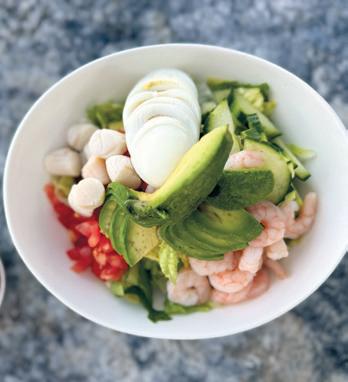

Seabrisa’s Eatery at Hollister Municipal Airport, run by husband-wife owners Lupe Farias and Kaley Arie, feels like the eclectic country home of world travelers. Sonoranstyle cacti share space with nautical ropes and suspended wooden airplanes.
My husband and I order the traditional Cobb from the menu and the seafood Cobb from the specials board. Each arrives meticulously arranged, chopped ingredients sectioned neatly over crisp iceberg, topped with dressings of our choice.
The seafood special—with baby shrimp, baby scallops and cucumbers replacing the chicken, bacon and blue cheese—lacks the savory depth that makes the traditional version so satisfying. But the classic Cobb hits the spot, thanks to judiciously seasoned chicken, crisp bacon and an artfully arranged avocado.
Pair it with a hike: At Hollister Hills State Vehicular Recreation Area, pass the
At The Farm Bakery, Cafe & Gifts in Aptos, the emphasis is on fresh, local and organic ingredients. The counter-service operation delivers a generous Cobb that stays true to the classic. The romaine is chopped and topped with sliced hard-boiled egg, half an avocado, diced chicken, bacon and tomato, and finished with a blue cheese crumble.
Generously portioned red wine vinaigrette makes this a sourish salad, but a touch of salt helps balance the flavors. Cafe owner Michelle Whiting says the key to The Farm’s Cobb is its high-quality ingredients: thick smoked bacon, organic chicken and local Glaum eggs.
Pair it with a hike: The Forest of Nisene Marks State Park offers the glorious Monte Toyon Vista Loop, with towering redwoods and wide trails. Accessible option: The Waggoner Overlook Trail is a short, paved path through the forest to a scenic picnic spot.
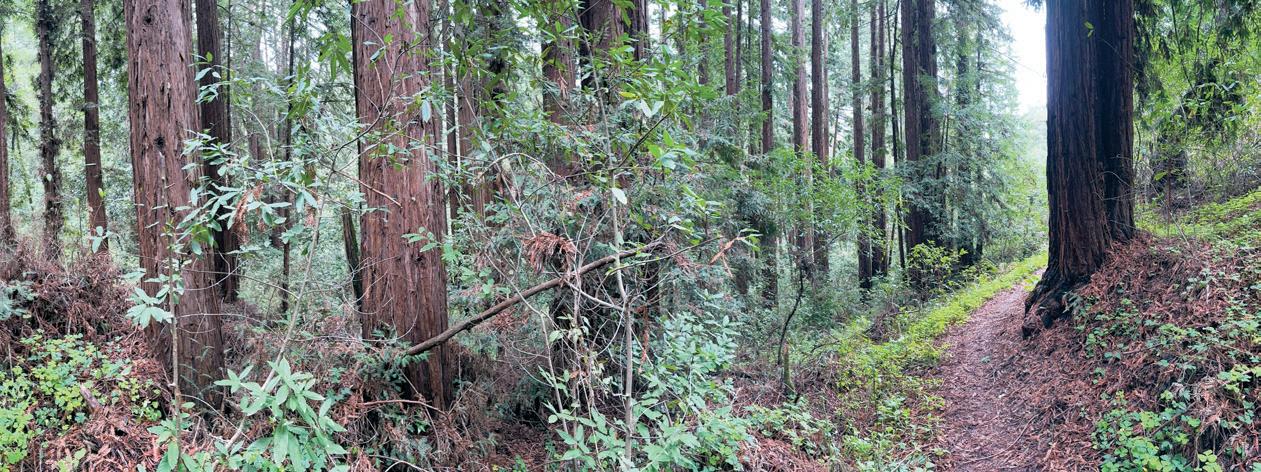
Msimple salad offers endless variations, each reflecting its locale through thoughtfully sourced ingredients and chef-driven touches.
mula while introducing subtle innovations.
across textures, flavors and proportions. The most exemplary salads feature high-quality pro teins, peak produce and housemade dressings that unite rather than dominate.
coastal redwoods of Aptos, the oak-studded hills of Carmel Valley and the Cretaceous crags of the Gabilan Range—the region’s Cobb salads offer distinct terrains of taste, each worth exploring.

Courtesy Fernando Reyes, executive chef, Valley Kitchen at Carmel Valley Ranch
3 hard-boiled eggs
6 slices thick-cut lardon
3 heads organic baby mixed green lettuce
3 cups free range chicken breast, chopped
1 cup cherry tomatoes
¾ cup Point Reyes blue cheese, crumbled
3 green onions, chopped
1 fresh avocado, peeled, pitted and diced
8 ounces creamy blue cheese dressing
1 cup cucumber, sliced
Place eggs in a saucepan and cover completely with cold water; bring to a boil, then cover and remove from heat. Let eggs sit for 10-12 minutes, then cool, peel and chop.
While the eggs are cooking, place lardon in a sheet pan. Cook over mediumhigh heat until evenly brown, 10-12 minutes. Drain, chop and set aside.
Divide the organic lettuce among individual plates. Top with rows of lardon, eggs, free range chicken, cherry tomatoes, blue cheese, English cucumber and avocado.

Drizzle with the creamy blue cheese dressing. Serves 6.

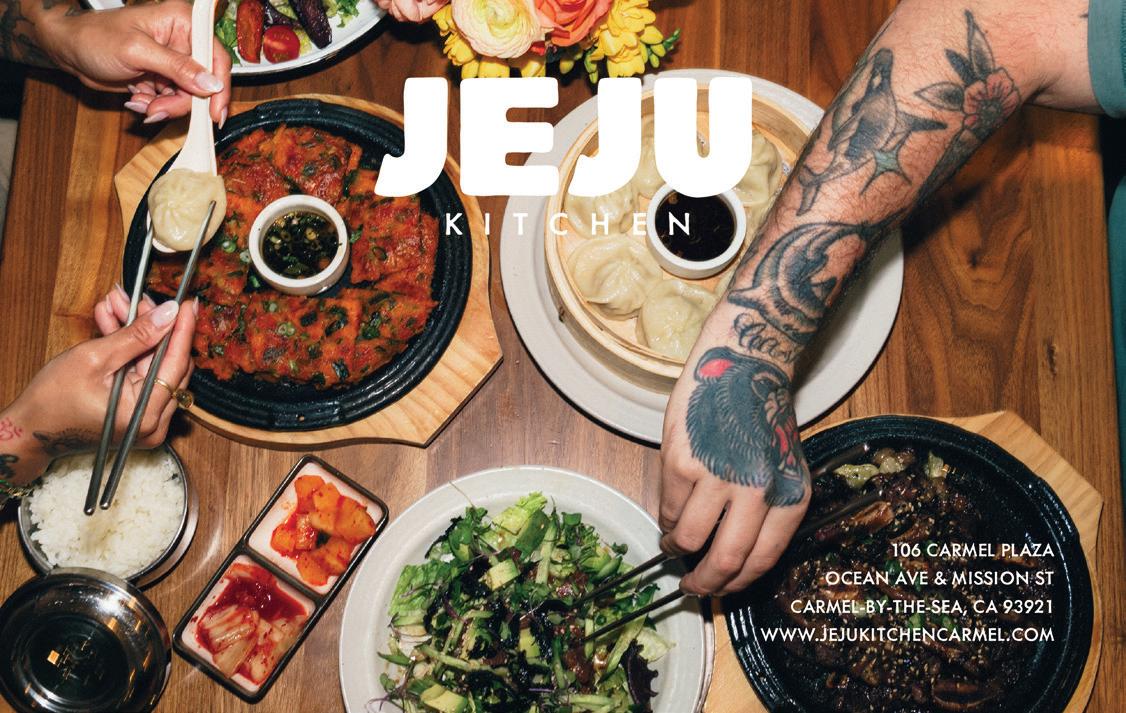




Photos by Jim Sullivan
by Drew Deckman
Back from the brink of extinction, the Pacific bluefin tuna population is rebounding at an impressive pace. A strong, global management plan will ensure its long-term survival.
From my years spent cooking across Europe to my turn as a cocinero in Baja, Mexico, to my newest restaurant in San Diego, I’ve always served up the freshest local ingredients I can find. No matter what I’m cooking, I focus on the ingredients, not fancy techniques. When it comes to seafood, I opt for items that not only taste great but also promote the longterm health of our fisheries, our local fishing economy, and our ocean. Striking that balance isn’t always easy – especially when doing what’s best for the planet means avoiding popular seafood dishes.
For years, I left Pacific bluefin tuna – arguably the tastiest fish in the sea – off the menu due to severe overfishing by commercial fishing fleets from around the Pacific. By 2010, the stock had been depleted by 98 percent from historic levels. Fear of serving up one of the last Pacific bluefin tuna made it easy to take a pass.
But there’s good news: Pacific bluefin tuna is making a comeback. The science and management have improved such that last fall Monterey Bay Aquarium’s Seafood Watch – the gold
standard for chefs and consumers who want to source and eat seafood fished or farmed in ways that don’t harm the environment – upgraded some of its Pacific bluefin tuna recommendations from red (avoid) to yellow (a good alternative). In the 25 years Seafood Watch has been rating seafood, that’s a first.
What changed? In an unprecedented show of global cooperation, representatives of the Pacific nations that oversee Pacific bluefin set fishing quotas and an ambitious rebuilding target. The tuna fishing industry – including U.S. commercial and recreational fleets – followed the plan and reduced their catch. According to the latest stock assessments, the population size of Pacific bluefin tuna reached the initial recovery target more than a decade ahead of schedule.
locally sourced Pacific bluefin tuna into my menu. But don’t expect to find a Pacific bluefin tuna steak offered up as a main course. As the yellow rating suggests, we need to go slow and start with just a taste.
This amazing creature’s return is not only a win for tuna lovers and ocean conservationists alike, it’s also a win for local fishermen who want to do right by the fish but need to make a living. Again, it’s all about finding the balance between the long-term health of our fisheries, our local fishing economy, and our ocean.
There’s more work to do to get Pacific bluefin tuna to a Seafood Watch green – best choice – rating. The Pacific nations – including the United States – must put a plan in place that assures the long-term health of the fishery. I’ll be watching what comes next and will pull Pacific bluefin off the menu at the first sign of trouble. But I’m hopeful the momentum we’ve seen to date will get us to a place that lets me keep serving Pacific bluefin tuna – and ultimately gets it to green.

Deckman is a Michelin star chef on a mission to revolutionize sustainable food culture by committing to zero waste and prioritizing sustainable sourcing. In addition to establishing multiple restaurants in Baja, Mexico, he recently opened 31ThirtyOne in San Diego’s North Park neighborhood. Serving only locally sourced ingredients, he donates 1% of monthly revenue to help farmers implement carbon farming projects. Deckman is a member of Monterey Bay Aquarium’s Blue Ribbon Task Force.
So, where does that leave chefs who are grappling with whether to serve this delicacy? It’s not a decision I made lightly, but as we await the start of Pacific bluefin tuna season here in Southern California, I’m dreaming up new recipes and making plans to integrate Learn More



A wine destination glows up, adds texture and looks heavenward STORY AND PHOTOS BY
MARK C. ANDERSON
Against the post-sunset sky at immersive art exhibition Sensorio, the planets align.
Venus, Saturn, Jupiter and Mars appear to the naked eye, while Uranus and Neptune linger in the background, visible by telescope.
As the “planetary parade” (as astronomers call it) dances across the mild winter night in Paso Robles, Sensorio has its own otherworldliness at work.
First Field of Light sprouts 100,000 solar-powered stemmed spheres across 15 acres of wavy terrain interspersed with walking paths and oak silhouettes.
Then Light Towers illuminates 69 columns of some 17,000 wine bottles wired with radiant optic fibers that

change colors with the ambient score.
Next DIMENSIONS invites earthlings into a labyrinth of large-scale geometric sculptures casting pattern and shadow and movement.
From there the experience widens, with installations like Gone Fishing and Fireflies and Fiber Optic Symphonic Orchestra transcending their titles, complemented by optional local wine, craft beer and wood-fired pizza on the terrace above Field of Light.
Along the odyssey, one visitor looks to the sky, then the hills, and I hear him mumble in awe, “Sure is the right night.”
Paso Robles, simultaneously, is encountering its own planetary alignment.
It’s grown up enough to enjoy a restaurant scene to match the world-class wine—and to add newer luxuries like a jazz speakeasy—but humble enough that it retains eagerness to please.
Travel Paso spokesperson Sierra Mercado grew up in nearby Atascadero but didn’t appreciate the Paso paradox of cool-but-not-too-cool until working in the wine industry.
“Paso Robles is out there enough, but it’s still kind of a hidden gem, with a lot more to explore,” she says. “What I like is that it’s more relaxed—you can go from exercise class straight to a wine tasting, with no judgement, and it still has the family touch, everyone is beyond friendly. So when people visit, that radiates off the town.”
What follows are additional takeaways from a three-night stay just south of Monterey County, which earn Paso Robles the first slot in EMB’s new regular series “Appetite for Travel.”
Embrace accessibility, including vending machine gourmet.
Just off the downtown exit from Highway 101, a good sign of what’s ahead materializes on the side of Riverside Avenue. A sandwich board directs hungry audiences to the nearby charcuterie-and-cheese vending machine by boutique purveyors Cured and Cultivated.
The digitized box with 35 offerings and a Cheddar wheel emblem reading “24/7” comes through ably—everything-you-need-nothing-you-don’t style—with tubs of stuffed olives, satchels of Marcona almonds, wedges of boutique cheese and tubes of fine imported salami.
My tastemate and I leave with fancy crackers and a pre-bundled medley of artisan Central Coast Creamery hard cheeses (no $95.75 ramekin of Sturia Oscietra caviar), to go with the complimentary bottle of Paso



wine that surprises us at Stables Inn, which follows a similar formula to the CandC vending module: a humble frame, reworked with clever and attentive updates, which maximize style and convenience.
Within a few blocks of Stables Inn await small-batch sweets (including legendary Brown Butter Cookie Co. and storied Negranti Creamery), history (note the 1900sera foot pedal water fountain and El Paso de Robles Area History Museum), bespoke caffeine (Spearhead Coffee) and a relatively new rum bar (Cane Tiki Room).
“I like to think we’re not missing anything!” Mercado says.
Downtown also enjoys the August 2020-debuted Paso Market Walk, 16,000 square feet appointed with tenants like Momotaro Ramen, Just Baked Cake Studio & Bakery, The Vreamery Artisan Vegan
Left to right, a quiet moment before the brunch bonanza at Parchetto; the living wall lounge at Booker Wine rivals the dramatic tasting spaces at higher elevations; over at Finca, the chili butter oysters command center stage, with a superb supporting performance from the ceviche of the day.
Cheese Collective, and Hog Canyon Brewing Co.
So sticking around the grassy—and by night, string-light illuminated—Downtown City Park square is a formula for happiness.
But so is getting further afield. Any true paso through the robles should involve vineyards.
There’s a lot more than big reds to believe in.
Paso Robles and its now 200+ wineries first rose to renown around hot-climate varietals—think full-bodied zins from Turley and Peachy Canyon, or lesser-known-butno-less-spectacular cab and petite sirah from Indigené Cellars.
Now a number of its most remarkable winemakers are pursuing fresher formulas, with sublime results.
Two in particular impress the eye and imagination.
Kukkula Wine’s architecture, summoning weathered steel and gabion stone, leans into the land of the Adelaida District, one of 11 Paso region AVAs whose microclimates help drive new and diverse area expressions.




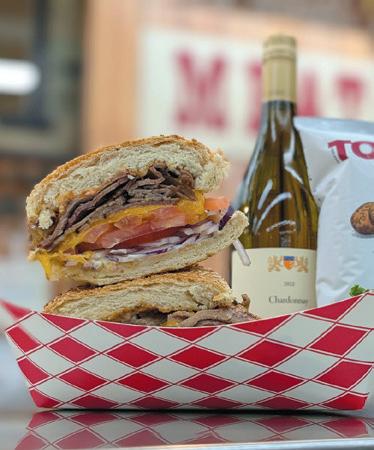

Its dry-farmed and low-intervention wines tune into Rhone varietals happy in this climate, and take Finnish names honoring its creator’s heritage (kukkula means “hill”).
Standouts include the vaalea (or “light”), an airy blend of grenache blanc, viognier and roussanne, and the karu (aka “rugged”), a savory blend of grenache and counoise, the latter a favorite of founder Kevin Jussila.
Booker similarly bends boundaries of beauty through space and taste. So much so, if you could only visit one winery while visiting Paso, 1) That would be a cruel fate; and 2) You could make a case this is it.
That’s a result of striking design—including an inside-outside tasting salon and an underground lounge with a “living” wall—that rises to the heights of Booker’s all-organic estate juice.
The wines we feel compelled to take home include a ballerina-graceful 100% grenache and a splurge-worth signature syrah called Fracture.
Our host, tasting room lead Jonah Dewhurst, leaves us with a thought that departs from the sleek sophistication of the winery, yet remains comforting.
“I don’t think Paso will lose its smalltown vibe,” he says.
Foodie cred is often only as real as its community.
A good place to view Paso’s transformation from dustier—sleepier?—cowboy crossing to wine country destination would be a short stretch of 13th Street a block from Downtown City Park, now plump with restaurants, tasting rooms and cafés.
Maggie Cameron uses a different word for the zone she helped overhaul by coopening The Hatch Rotisserie & Bar, a Michelin Guide selection centered on livefire spinning chicken and a curated roster of craft whiskeys.
Her choice: “sketchy.”
That’s hard to picture as she moves amid a buzzy scene at Hatch’s next door sister, Della’s Wood-Fired Pizza & Cocktails.
A botanical gin-and-tonic program drops globe goblets of The Bops (Earl Grey, Fever Tree Tonic, lemon, marigold), The Bangers (with pineapple and cloves) and The Ballads (butterfly tea, orange, thyme), some starring local Tin City Gin (see sidebar, p. 67).
“We like our cocktails here,” beverage chief Robin Wolf says.
Thatcher Winery lets hens play hostess, while the soaring barn across the parking lot provides habitat for barn owls and selfies.


Meanwhile Girl Crush, Main Squeeze and Chicago Fire pizzas made with 72hour cold-fermented dough fly from a Fiero Forni wood-burning oven in the open kitchen, accompanied by an index of upscale crust dippers and Italian-like Bolognese pappardelle made with another Tin City star, Etto Pasta (see recipe, p. 67).
It all feels big-city, only friendlier.
One stop can be enough.
The feeling arrives as an arresting spread of signature salsas and asparagus-broccoli tacos at Fish Gaucho, from the same folks behind Paso staple Pappy McGregor’s, hasn’t begun to sink in—and as we’re descending to Libretto jazz club below.
It’s the sense, hello again, that a code has been cracked, a serendipity seized.
Libretto represents the newest revelation to develop a local, regional and tourist following among several local music venues—like Vina Robles Amphitheatre and Paso Robles Event Center—only far more intimate.
It seduces on sight and sound thanks to custom art, exposed limestone walls, 62seat capacity and sumptuous acoustics. Then the full gallop of the unicorn that
is its 9-foot Steinway & Sons concert grand piano hits, and you understand why top touring musicians go out of their way to play it: There’s a certain synergy hard to find elsewhere.
Flavor acts as a magnet.
The Japanese yellowtail ceviche of the day, with avocado, crab and tarragon oil, does an unlikely parlay of refreshing and rich. The fresh Baja fish tacos are a credit to the genre, beer battered and laced with habanero salsa. The chili butter oysters slide down so fast, it’s hard to be happy you had them...because you’re so sad they’re gone.
I didn’t need Travel Paso to flag Finca, tucked on the eastern edge of Paso Market Walk hall in one of the city’s oldest surviving houses, as a priority.
I’d stopped by on past voyages for duck al pastor tacos, crunchy potato tacos, pork belly chile verde tacos and hot honey grilled chicken tacos (all with glorious La Rosa flour tortillas out of Watsonville).
One additional development at work here (besides great margaritas): It delivers one of an increasing number of creators, entrepreneurs and artists not leaving for more visible markets, but just the opposite.







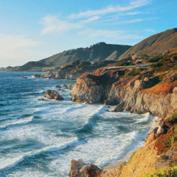



Finca co-owner/chef Patrick Aguirre chose Paso after a successful run cooking for the likes of Thomas Keller at Bouchon Bakery and Suzanne Goin of A.O.C., and starting Michelin Guide favorite La Taquiza Fish Tacos in Napa.
While at Finca, an extended relative of mine happens to pull up. Megan Mouren (and her husband Spencer Rawles) moved from Los Angeles, trading a trendy retail fashion career for work managing the family’s rising wine label High Camp.
“We wanted to pursue a different craft somewhere with open spaces, less traffic, a slower pace, and land and space for our animals,” Mouren says. “And explore the creativity of making wine while paying homage to past family ranchers and farmers.”
This type of reverse migration—Sensorio being a Burning Man import—brings a place at the intersection of Highway 101 and Highway 46 to a crossroads that could be called a sweet spot.
“Some [new residents] want to shut the door after they get here,” Maggie Cameron says, “and keep it as they found it.”
Funky proves fabulous.
At River Oaks Hot Springs Spa, two ever-present Paso elements—stoic oaks and undulating lines of grape vines—frame a local rarity.
Here the private bathing decks combine those soothing views with tranquilizing waters, optional wellness treatments and another local touch, available wine flight “sip and soak pairings.”
The creaky wood structures, vintage paint job and industrial faucets
Stables Inn is part of the Four Sisters Inns, which manages 20+ old-school bed-andbreakfasts in the state, and partners with Edible Monterey Bay on making travel that much more appetizing.
on the tubs don’t match the cushier welcome lounge and locker room, but for those looking for a little rustic texture, that’s a feature not a flaw.
Mercado calls it an “intimate getaway” that’s a few minutes from the center of town.
“If you’re looking to totally Zen out, that’s the go-to spot,” she says. “You don’t have to leave Paso, but it feels like you do.”
Planets don’t ask what time it is.
Brunch time at Parchetto, and the food—notably the dynamite South American mussel-shrimp stew—is the only surprise bigger than how slammed and bustling the place is. That contrasts theatrically with the smooth three-piece ensemble playing in front of the glass wine cabinets.
Later that day, a different harmony emerges. At Thacher Winery, homespun hospitality mingles with views of vineyards and hayfields as chickens cluck and scuttle underfoot, and the wines carry playful names that honor the interplay between human and climate, and soil and vine, like Closed Chaos and Serious Play.
Both Parchetto and Thacher would feel like revelations if they weren’t so well packed with people already, experiencing their own gamut between homey and overrun.
At Thacher, something else sticks out: The converted stables that serve as private tasting venues, and the transformed farmhouse with the wide wraparound decks that work as a welcoming sipping space, shrink in comparison to the soaring 100-year old KR Barn across the gravel parking lot.
In the KR’s rafters lives a family of barn owls we greet after our tasting. Barn owls are often associated with wisdom, knowledge, intuition and…change.
I tuck the thought away while we head to our final dinner downtown, at a place called The Alchemists’ Garden.
We flagged it from the Paso Travel’s suggestions because it tracks an inspired mission, namely the study of alchemy—which felt on brand in a place mixing inviting ingredients—and its tagline as “a bar and restaurant manifested by dreamers to inspire creativity.”
The food and drinks land with creativity and verve, highlighted by harissa tiger prawns with sunomono cucumber salad and tzatziki, burrata with compressed strawberries and an Alchemists Gold with crème de banane, Angostura, turbinado, cacao nib-infused bourbon and mesquite smoke unleashed from a wooden box.
Before we leave, our server—who hasn’t led us astray yet—encourages us to check out the surface of Alchemists’ bar, which sits beneath a bank of hanging pothos plants.
He references the auspicious time the spot debuted in 2020, in time to encounter COVID drama, and how it’s rediscovered its Paso path.
The bar, he says, reveals something reflecting the moment the place opened: the alignment of the planets.
Notes on a bonus flavor haven and a recipe from its star
Having two distinct eat-and-drink districts in one burgeoning city is better than one.
Tin City delivers a critical mass of walkable attractions 3 miles north of downtown, including 20+ small-batch wineries, family-owned BarrelHouse Brewing Co., Tin City Cider Co., Tin City Distillery, Michelin-starred Six Test Kitchen’s tasting menu spot and the 3-hour Taste of Tin City Walking Tour to hold your hand if that’s helpful.
What also helps is a major anchor like Etto, a shop-supply-eat-drink super spot whose noodles are worming their way into more and more local kitchens and eaters’ affections, while starring in this recipe.
Courtesy Brian Terrizzi, owner, Etto Pasta in Paso Robles Etto founder Brian Terrizzi dedicates Etto: The Pasta Cookbook an Edible San Luis Obispo Cookbook to his team, and includes photos of them in action as further tribute. He also packs in a lot of pasta. He introduces this dish with a personal nugget: “As a kid I was a little scared of eggplant. I think it was the name…So let’s just use the Italian name: melanzana. Sicilians considered melanzana to have medicinal qualities and to also lead to folks having a grumpy disposition: ‘I swear it’s not me, it’s the melanzana.’” More at ettopastificio.com.
1 large eggplant, or 2 small eggplants, cut into ½- to ¾-inch cubes (unpeeled unless skin is very tough)
2 tablespoons Italian seasoning
2 tablespoons “00” flour, or allpurpose flour
2 tablespoons extra virgin olive oil
2 cloves garlic, finely chopped
1 to 2 tablespoons tomato paste ¼ cup whole milk, warmed
½ cup tomato passata, or crushed tomatoes
1 pound dried Etto pasta
Ricotta salata, crumbled, for serving Kosher salt
Freshly ground black pepper
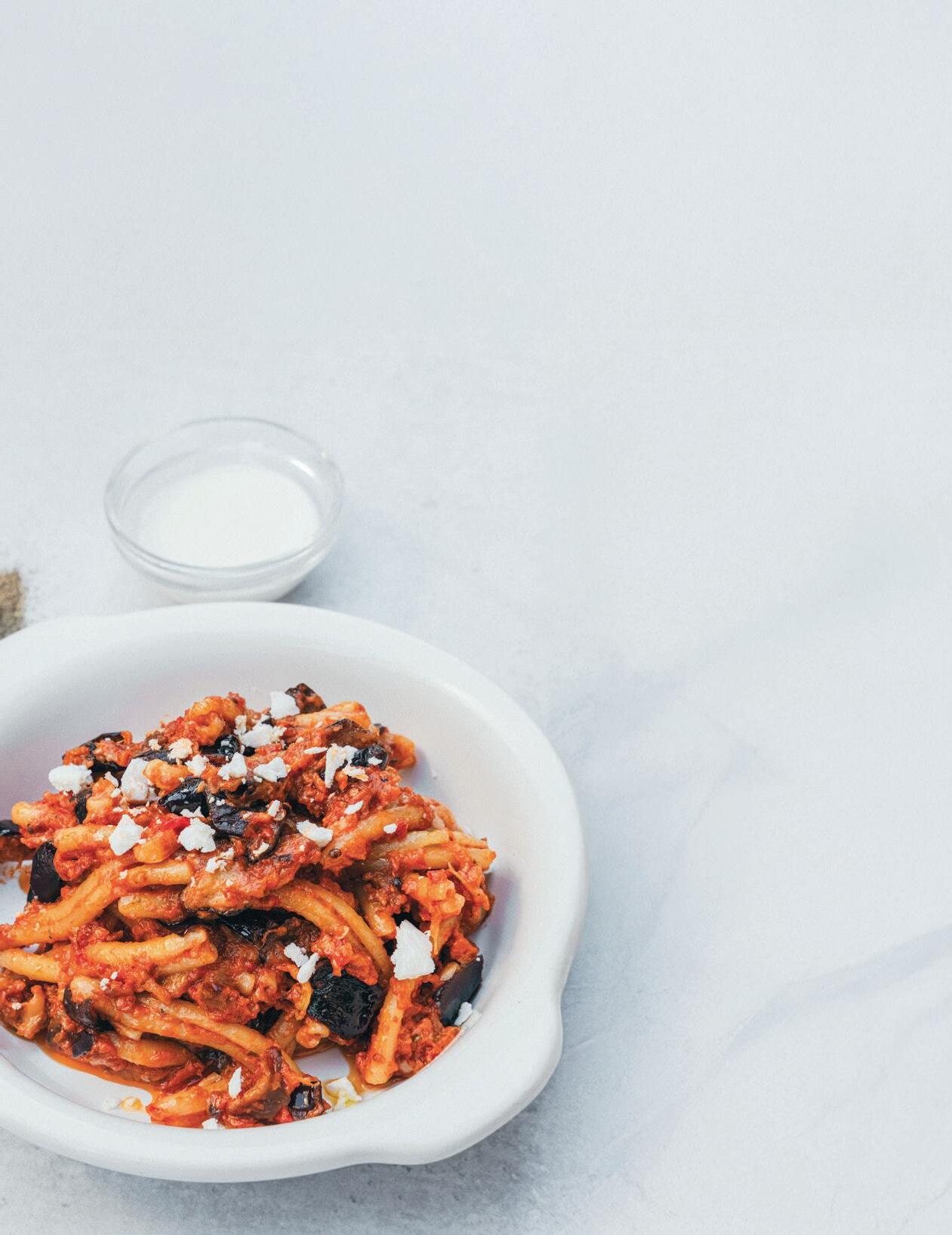
In a large bowl, toss eggplant cubes with Italian seasoning, flour, and salt and pepper to taste. Moisture from the eggplant should help everything stick.
In large wok or skillet, heat olive oil over medium high heat.
Add seasoned eggplant and cook, tossing occasionally, until beginning to brown, about 5 minutes.
Add garlic. Continue to cook and toss over medium heat for about another 5 minutes, until eggplant is tender. Add squirt of tomato paste and cook until beginning to caramelize, about 1 to 2 minutes. Stir in milk. Continue to cook over medium low heat for 2 to 3 minutes more, until slightly reduced. Add tomato paste and stir to combine. Cook until mixture is heated through.
Meanwhile, in a large pot bring 4 quarts water to a boil and add 1 to 2 tablespoons salt. Cook pasta to al dente, according to package directions. Drain pasta, reserving about 1 cup starchy pasta water.
Add pasta to skillet and toss to combine, adding pasta water needed to create a creamy, chunky sauce. Divide into warm bowls and top with ricotta salata. (Tip: I put some in the bottom of the bowls too.) Serves 4–6.




BY DEBORAH LUHRMAN PHOTOGRAPHY BY CHEYENNE ELLIS

Head towards the coast, make a left and you’ll be on one of the grandest drives in the United States. It’s scenic for sure, but also one of the most productive and bountiful stretches of real estate for food lovers.
The plentiful foodways of the Central Coast are something we celebrate in every issue of Edible Monterey Bay, so I couldn’t wait to get my hands on a copy of chef Scott Clark’s new cookbook Coastal: 130 Recipes From a California Road Trip and read about our area from a chef’s point of view.
“It’s been burned by wildfires, desiccated by drought, and swallowed by flooding and landslides,” he writes in the introduction. “But somehow, this place perseveres, providing a cornucopia that chefs like me, and the people who eat our food, are fortunate enough to enjoy.”
Clark is a veteran of multi-Michelin-starred restaurants like Benu and Saison in San Francisco, but in 2017 he left the world of high-pressure kitchens, got sober and started running ultramarathons.
He now operates his own roadside eatery in a converted red caboose alongside Highway 1 in Half Moon Bay. It’s called Dad’s Luncheonette and dedicates itself equally to serving simple comfort foods and maintaining a sane quality of life. To wit, Dad’s grassfed burgers and maitake mushroom sandwiches are only available from 11am–4pm, Thursday–Sunday.
Published in March, Coastal is a “love letter” to the Central Coast.
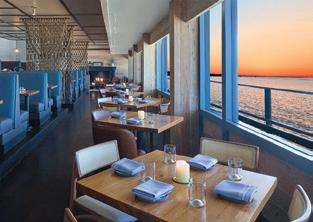


On some of his days off, Clark has been visiting purveyors along the coast. From Half Moon Bay to the Channel Islands, he met with farmers and fishermen, foragers and ranchers, hunters and winemakers.
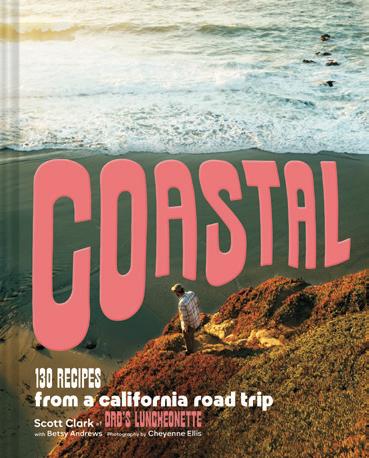
He also went surfing, sailing, kayak fishing, foraging, shopping at farmers markets and picnicking on the beach with his young daughter Frost.
The book—written in collaboration with award-winning food journalist Betsy Andrews—weaves together his adventures and recipes inspired by each journey, along with profiles of people he meets along the way.
In one section, for example, he gathers mushrooms in Del Monte Forest with local forager and chef Anthony Gerbino—former owner of Julia’s Vegetarian Restaurant in Pacific Grove—and Clark emerges with two recipes: Porcini with Guanciale Ravigote and Chicken-Fried Morels with Red-Eye Gravy.
On a different page he pops in on Dee Harley at Harley Farms Goat Dairy in Pescadero, a visit that anchors a chapter of unusual breakfast ideas, like Brussels Sprout Latkes and Asparagus Grain Bowl Benedict.
Later, he takes his daughter to the Downtown Santa Cruz Farmers Market to shop the huge variety of fresh organic produce and scarf down a couple of cones from The Penny Ice Creamery—a trip that inspires a recipe for Pumpkin Bread with Salty Butter and kid-friendly Watermelon Agua Fresca.
Jumping from one idyllic spot to another, always within sight of the Pacific Ocean, Coastal is a kind of magical mystery tour. The book itself is designed with psychedelic day-glo orange recipe titles and 1960s-style bubble writing on the cover, lending it a California Dreamin’ quality.
“For me this isn’t only a cookbook. It’s a love letter to my chosen home, California’s Central Coast,” Clark writes.
When it comes to defining the essence of Central California cuisine, the author has a few tricks up his sleeve.
Seafood and foraged ingredients are a big part of the fare—from the melted anchovy sauce on his charred broccolini to the Japanese-inspired Seaweed-Shiitake Miso Soup.
He also makes liberal use of Meyer lemons throughout the 130 recipes, like the roasted snap pea salad (see recipe, page 71).
Another secret flavor bomb that Clark makes by the quart—and uses in many of the recipes in the book—is Umami Oil, which incorporates shiitake mushrooms, kombu and bonito flakes.
“I’m constantly striving for the best and simplest way to make flavors sing, full throttle,” writes Clark. And full throttle is the perfect way to experience the Central Coast.
Deborah Luhrman is the publisher of Edible Monterey Bay
Courtesy Scott Clark, chef and owner, Dad’s Luncheonette in Half Moon Bay
Here’s a dish that my daughter Frost and I call our Inner Smile Salad. It’s everything you want for a cookout. It’s super easy, so you can make it ahead and bring it in a Tupperware. Or you can prop a cast-iron pan on the beach flames and make it right there and then. After a hot fire, lots of sun and piles of grilled meat, it’s a hydrating, cooling, creamy, green gift that’s fun to eat, with a mix of savory elements tucked amid the sweetness that Frost loves. We hammer bowls of it. The dressing is my knockoff of a Japanese probiotic milk drink called Yakult. It’s fermented with a different strain of bacteria than yogurt, and that’s where it gets its citrusy tang.
For the Yakult-Style Dressing
½ cup yogurt, preferably homemade
1 tablespoon honey
2 teaspoons fresh lime juice
1 teaspoon fresh lemon juice, preferably Meyer
In a small bowl, mix all the ingredients until fully combined. It keeps in the fridge in an airtight container, for up to 1 week.
For the Roasted Snap Pea Salad
1 tablespoon toasted sesame oil
12 ounces sugar snap peas, stems and fibrous ribs removed
¾ teaspoon kosher salt
3 Persian cucumbers
½ bunch fresh chives, cut crosswise into thirds
1 teaspoon toasted white sesame seeds
1 teaspoon black sesame seeds
In a 9-inch cast iron pan over high heat, get the sesame oil ripping hot and smoking. Drop in the peas and cook them without moving them until one side gets good and charred, 3–5 minutes. When they’re hissing at you and barely wanting to stay inside the
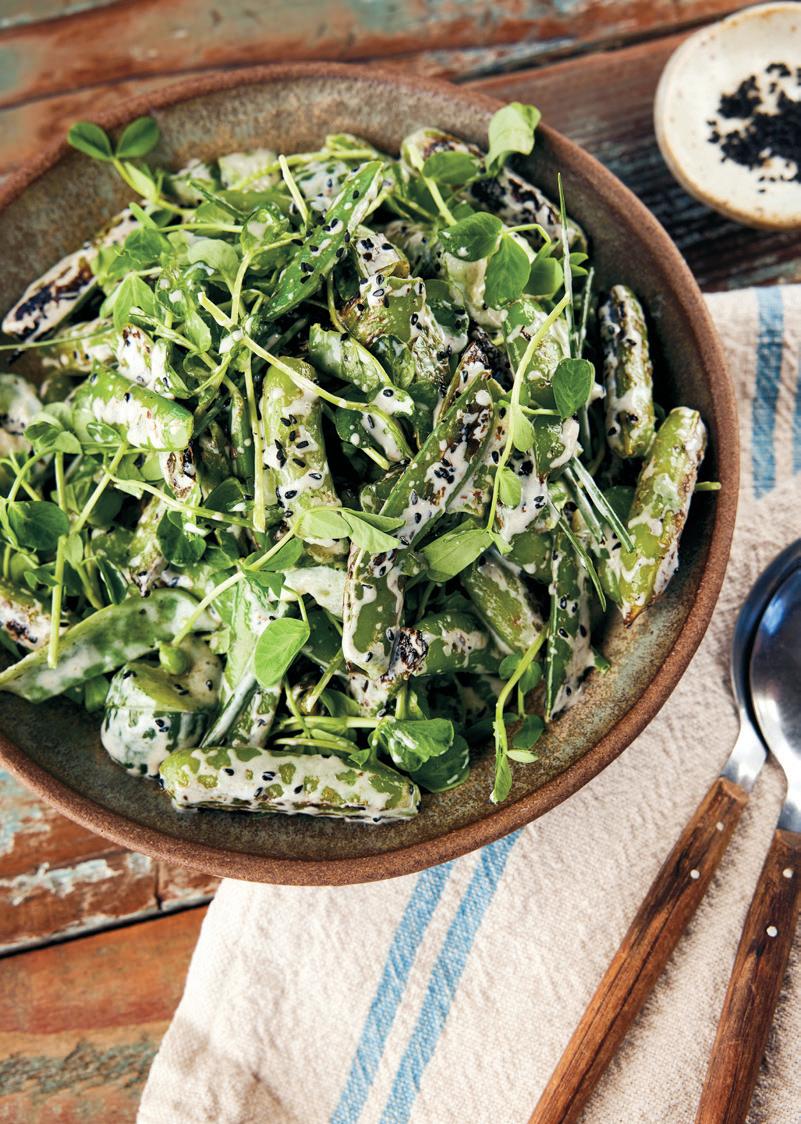
pan, give the peas a push. Some will turn over. Add the salt and continue cooking the peas for 3-4 minutes more. You want them unevenly charred. Put the peas on a sheet pan and stow them in the fridge or pop them in a cooler to get nice and cold, about 15 minutes.
Remove the tops and bottoms of your cukes. Holding your knife at a 45° angle, cut a chunk of cuke. Roll the cuke 180° and cut again to get weird, triangular pieces. Repeat with all the cukes, then smash all the pieces with the side of your blade. They’ll hold
together because their shape gives them maximum skin. Add the cukes and chilled snap peas to a serving bowl.
Add enough dressing to the serving bowl to heavily coat the veg and mix well. Toss in the chives and all the sesame seeds and serve. Makes 2–3 servings.
Excerpted from Coastal: 130 Recipes from a California Road Trip by Scott Clark with Betsy Andrews, © 2025. Published by Chronicle Books. Photographs © Cheyenne Ellis.
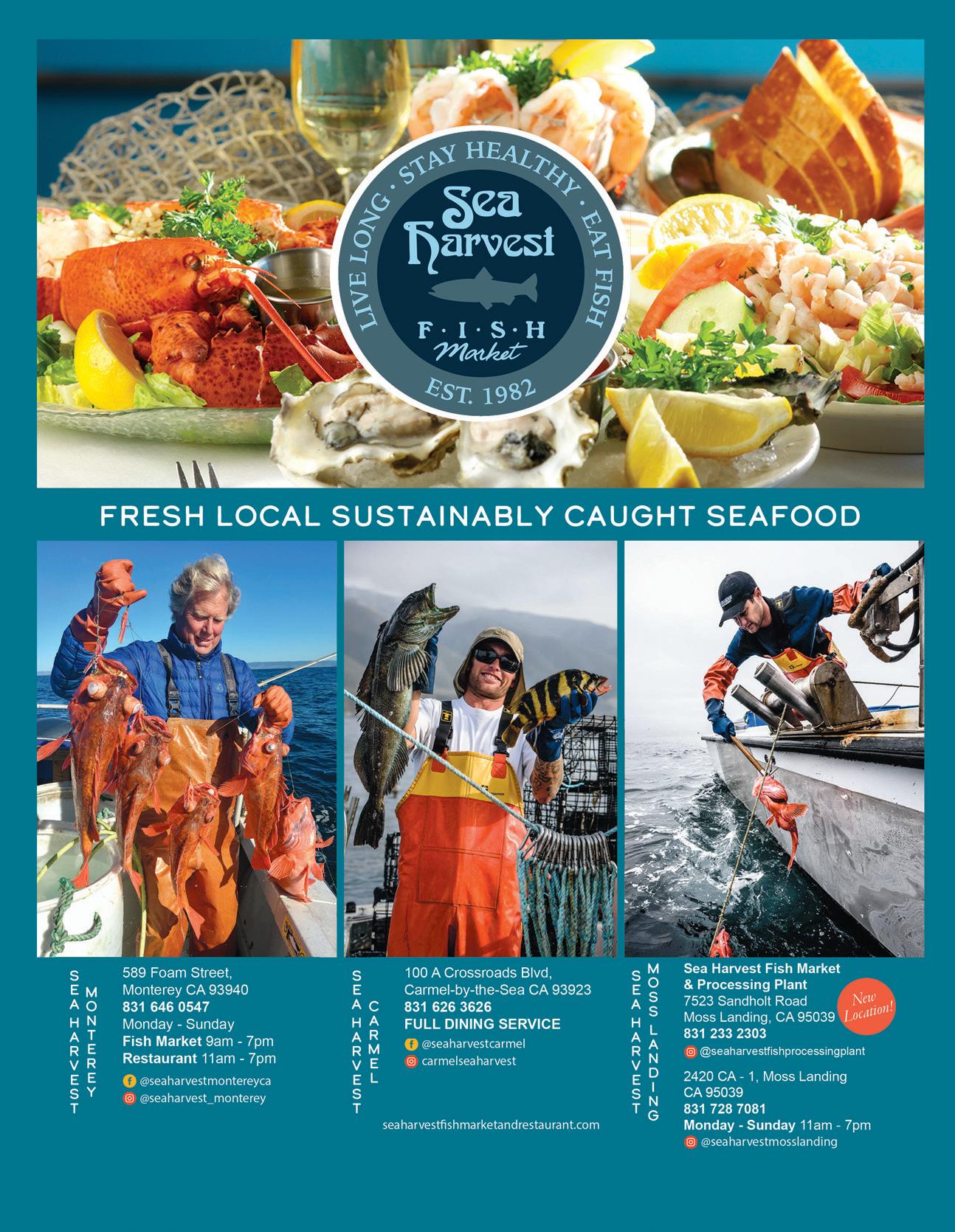




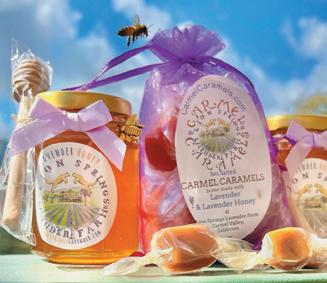


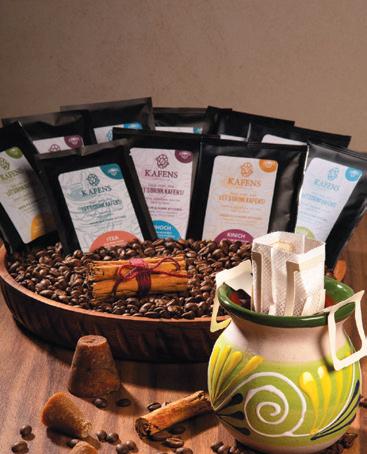










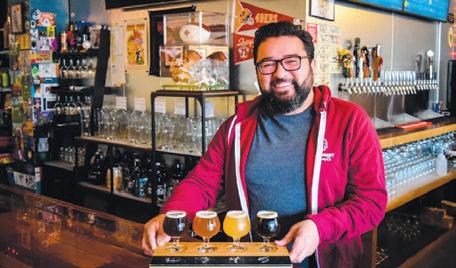



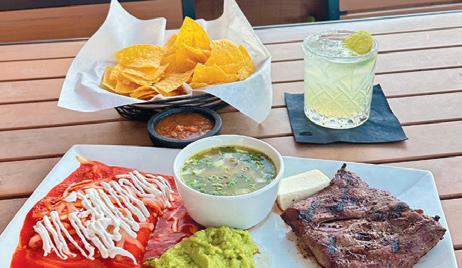









Cavalletta 9067 Soquel Drive
831-661-5010 • cavallettarestaurant.com
Chef-owners Shawn Ryberg and Nick Sherman (who also operate Trestles in Aptos) offer seasonal Italian-inspired fare in a laid back environment that includes a leafy deck overlooking Aptos Creek. Pizzas, salads, pastas and entrées are all made in-house using locally sourced ingredients. Short rib rigatoni, seafood scampi, focaccia with burrata and lasagna, served Mondays only, are fan favorites. The partners spent nearly a year perfecting their pizza dough, which is light and tangy, and blisters to perfection in the wood-fired oven. Open Th–F, M 5–9pm. Sa–Su 4:30–9pm.
Mentone
174 Aptos Village Way
831.708.4040 • mentonerestaurant.com
A fun twist on the cuisine of the Riviera, Mentone is a casual restaurant and cocktail bar from David Kinch—one of the country’s most acclaimed fine dining chefs. Kinch loves the Mediterranean coast where France meets Italy, and Mentone brings some of those flavors to California with appetizers like duck rillettes and stracciatella with olive oil produced just down the road. There are housemade pastas and a handful of bistro-style entrées like pan-roasted black cod and steak frites, but the main draw is pizza—pulled bubbling hot from the Valoriani woodfired oven and loaded with Italian toppings. Open W–Su 5–9pm. Lunch Sa–Su noon–2:30pm.
All of these restaurants emphasize local ingredients and they also advertise in Edible Monterey Bay! Please check hours online before you go and tell them we sent you.




Persephone
7945 Soquel Drive
831.612.6511 • persephonerestaurant.com
With a namesake like the mythic Persephone, this restaurant in Aptos proclaims its deep reverence for seasonal cooking. Themes central to harvest, winter and spring are core to Persephone’s story, and are reflected in the changing menu at this fine dining destination, where chef Cori Goudge-Ayer presents inventive, ingredient-driven creations. The restaurant is a family-run passion project, bringing together parents, siblings and a long history of culinary arts in a beautifully redesigned

space overlooking Aptos Creek. Open for dinner W–Sa 5–8:30pm. Fourth Sundays, Winemaker Dinner with five-course pairing menu.
New Leaf Community Markets
161 Aptos Village Way
831.685.8500 • newleaf.com
The Aptos branch of the beloved local market group occupies the remodeled Hihn Apple Barn, built in 1891. In addition to local groceries and organic produce, New Leaf Aptos has made-to-order sandwiches, pizza, freshly rolled sushi, soup and hand-prepped salads, as well as a coffee bar, juice and smoothie bar and organic Straus soft serve ice cream. Open daily 8am–9pm.
The Penny Ice Creamery
141 Aptos Village Way, Suite 2
831.204.2523 • thepennyicecreamery.com
Open Su–Th noon–9pm, F–Sa noon–10pm. See The Penny description under Santa Cruz for more.
Seascape Foods
16B Seascape Village • 831.685.3134
A charming family-owned market with an ample deli counter featuring daily chef specials, salads, breakfast items, freshly squeezed juices and sandwiches on housemade organic sourdough bread. The grocery section includes organic produce, artisanal products, local beer and wine, and gifts. Eat outside next to the fountain on the patio or take your goodies to the beach nearby. Open daily 8am–8pm.
Big Sur River Inn Restaurant & General Store 46800 Highway 1
831.667.2700 • bigsurriverinn.com
The River Inn opened in 1934, selling homesteader apple pies to locals and travelers. This small family business is known as “the place with the chairs in the river.” Food and drinks are all made from scratch. Enjoy your meal under the redwoods with a view of Big Sur River or with your feet in the water. Visit the Burrito Bar for tasty graband-go fare to fuel your Big Sur adventures. Open daily 8am–8pm.


Capitola Wine Bar and Merchants
115 San Jose Avenue
831.476.2282 • capitolawinebar.com
Where the wines meet the waves, Capitola Wine Bar can be found in the seaside village of Capitola and offers small batch wines hand selected by its team of certified sommeliers. Wines from all over the world are available, by the glass, bottle or flight, along with local beers and a great kitchen. The menu includes charcuterie plates, salads, flatbreads and desserts, as well as Doug’s “Cup of Mac.” Events are always happening like Live Music, Paint Nights, Trivia Nights, Wine Blending and more. Don’t miss the dog-friendly patio and the $7 happy hour W–F 5–7pm. Open W–Su. For more information see website.
Gayle’s Bakery & Rosticceria
504 Bay Avenue
831.462.1200 • gaylesbakery.com







A favorite with locals and a must-stop destination for visitors since 1978, Gayle’s Bakery offers freshly baked breads, pastries, cookies and cakes every day of the week. The rosticceria is famous for its soups, salads, sandwiches and rotating Blue Plate Dinners, which are served hot and also available from the grab-and-go case to reheat at home. A dining patio with a fireplace and occasional live music make Gayle’s a community gathering place as well. Open daily 6:30am–7:30pm.
New Leaf Community Markets
1475 41st Avenue
831.479.7987 • newleaf.com


Just opened in November, the new Capitola New Leaf Community Market occupies a larger footprint at 24,000 square feet, allowing expanded sections for organic produce, meat and seafood. The store also has increased its natural wellness section and its hot and cold food to go options. Enjoy California BBQ, fresh sushi and a self-serve poke bar. A coffee and juice bar offers locally roasted drip coffee and juices in reusable glass bottles. Open daily 7am–10pm.
The Penny Ice Creamery
820 41st Avenue
831.204.2523 • thepennyicecreamery.com
Open Su–Th noon–10pm, F–Sa noon–11pm. See The Penny description under Santa Cruz for more.
Trestles
316 Capitola Avenue
831.854.2728 • trestlesrestaurant.com
Just steps away from the iconic Capitola train trestle, chefowner Nick Sherman’s passion for great food is evident in every dish at his popular neighborhood bistro. Local seasonal ingredients star in appetizers like chicory salad, roasted fairytale pumpkin with goat cheese and mole negro, Brentwood street corn and crispy pork belly with watermelon radish. Entrées include smoked eggplant gnocchi, Niman Ranch pork chop and fresh fish—all served with local wines and craft beers on tap. Open W–F 5–9:30pm, Sa–Su 4:30–9:30pm.
Bruno’s Market & Deli

6th Avenue & Junipero Street
831.624.3821 • brunosmarket.com
Where the locals have been shopping for the past 72 years, Bruno’s Market & Deli is known for its quality groceries and friendly service. An array of specialty foods, as well as popular brands, an award-winning meat department and locally grown, organic produce await shoppers. For those with no time to cook, Bruno’s chef prepares fresh entrées to go, including its renowned hand-carved prime rib dinners Thursday to Saturday from 4pm until sold out. There is also an extensive wine selection for the connoisseur. Open daily 7am–8pm.

Covey Grill
8205 Valley Greens Drive
831.620.8860 • quaillodge.com/dining/coveygrill
Covey Grill at Quail Lodge features USDA steaks and sustainably sourced seafood complemented by unique plant-based offerings in addition to seasonal American cuisine. Covey Grill offers casually elegant indoor and outdoor dining options against the stunning backdrop of Quail’s sparkling lake and lush garden landscapes. Open for full dinner service 5–9pm M–Su, with bar opening at 4pm.
Earthbound Farm’s Farm Stand
7250 Carmel Valley Road
831.625.6219 • earthboundfarm.com


Earthbound Farm’s 100% certified organic kitchen de lights with specialty coffee and tea, soft serve ice cream and a made to order breakfast and lunch menu—includ ing soups, sandwiches, salads, baked goods, fresh juices and smoothies. Food is available to be enjoyed on the beautiful grounds or for takeaway. In addition to certi fied organic produce, the Farm Stand offers a selection of natural, organic, local beer and wine, groceries, gifts and flowers. Stroll through the gardens and learn about Earth bound’s commitment to organic integrity. Open daily, but check hours online as they change seasonally.



Edwin’s
6th Avenue & San Carlos Street
831.250.7744 • edwinscarmel.com
One of the liveliest corners of Carmel, Edwin’s combines live music with a flavorful menu of Asian fusion dishes rooted in the Philippines and Indonesia. This family-owned and operated spot always attracts a crowd to the bar, where guests can enjoy appetizers like satay and lumpia, with local wines and craft beers. The cozy dining room turns a meal into a group experience, with chef’s choice combo baskets and individual entrées like Balinese fried chicken and Singapore chili prawns. Open for lunch F–Su noon–3:30pm and for dinner W–M 5pm–close.


Grasing’s
6th Avenue and Mission 831.624.6562 • grasings.com
Chef-proprietor Kurt Grasing’s namesake restaurant has expanded since opening in 1998 to include two large dining rooms, multiple outdoor dining areas and the everpopular bar/lounge. A Carmel classic located in the heart of the village, Grasing’s serves California cuisine, with an award-winning wine list and a vintage spirits program featuring classic cocktails made with rare Mad Men-era gins, whiskeys, Camparis and amaros. Open daily M–F 11am–9pm, Sa–Su 10:30am–9pm.
Jeju Kitchen
Carmel Plaza, Ocean Avenue & Mission Street, Suite 106
831.574.8693 • jejukitchencarmel.com
Named for an island known as the “Hawaii of Korea” that grows divine produce, Jeju Kitchen is a buzzy spot with a mix of Californian and a modern update of classic Korean dishes. Inspired by her mother’s home cooking, owner Ashley Wolff serves up kimchi pancakes alongside coconut prawns and a crispy garlic Caesar salad; smash burgers with Gangnam tots, Jajangmyeon noodles and customer favorites—like the spicy bulgogi chicken and salmon rice bowl. Open daily 11am–8pm.

Sea Harvest Fish Market & Restaurant 100 Crossroads Boulevard, Suite A
831.626.3626 • seaharvestfishmarketandrestaurant.com
The Deyerle family that owns this local gem has its own fishing boats for the freshest catch on the Monterey Peninsula. Sea Harvest doubles as a fish market and casual restaurant with indoor and outdoor seating. The oysters and clam chowder are customer favorites, but don’t miss the fried combo platter, grilled fillets and fish tacos. Open daily 8am–8pm.











Stationaery
San Carlos Square, Between 5th and 6th avenues
831.250.7183 • thestationaery.com
Stationæry is a neighborhood restaurant in Carmel operated by Anthony and Alissa Carnazzo. Offering brunch, dinner, specialty coffee, and natural wines, they celebrate comforting flavors with elegant presentation. Led by chef Amalia Scatena, Stationaery primarily sources from Monterey and Santa Cruz county farms and ranches, according to what is fresh and in season. A take-away and bottle shop next door allows for to-go orders and a unique selection of Old World and domestic wines. Brunch daily 8am–3pm. Dinner Th–Sa 5:30–9pm.
Ad Astra Bread Co.
320 Mid Valley Center adastrabread.com
The first branch of Monterey’s popular Ad Astra bakery is set to open late spring/early summer in Carmel Valley with coffee, tea, pastries and heartier breakfast and lunch items, making good use of Ad Astra sourdough breads. Consult website for opening date and hours.
Carmel Valley Creamery
1 Esquiline Road
831.200.9532 • carmelvalleycreameryco.com
French-born cheesemaker Sophie Hauville crafts mouthwatering artisan cheeses and brings new life to a historic Carmel Valley building that sits close to the river and used to house a community gathering spot, Rosie’s Cracker Barrel. There is fresh goat cheese, fromage blanc, a bloomy rind Camembert and aged cheeses infused with coriander and peppercorns. Customers can watch cheese being made through glass windows, while they sip espresso drinks, nibble Ad Astra pastries or shop a curated selection of artisanal food products and gifts. Open daily 7:30am–5pm.

Jerome’s Carmel Valley Market
2 Chambers Lane
831.659.2472 • jeromescarmelvalleymarket.com

A chef-owned, friendly neighborhood market, Jerome’s offers local and organic produce, natural meats and seafood, and a great selection of domestic and imported wine, beer and microbrews. French-trained chef and owner Jerome Viel prepares delicious hot foods, sandwiches and salads for eating at outdoor seating or take-away. The offerings start with breakfast burritos, croissants and other French pastries in the morning, followed by favorites such as coq au vin, spaghetti carbonara and chicken enchiladas for lunch and dinner. Open M–Sa 7am–7pm, Su 7am–6pm.
Sunny Bakery Cafe
18 E. Carmel Valley Road 831.659.5052 • instagram.com/sunnybakerycafe
Friendly local café offering homemade pastries, espresso drinks and light fare. Warm, welcoming service and a great array of treats made daily on site with wholesome ingredients that honor the seasons. Owner Analuisa Bejar heads the locally-minded kitchen with favorites like egg sandwiches, quiches, panini, frittatas, and irresistible BLTs. Buttery pastries, cookies, cinnamon rolls, muffins and cakes round out the list. Open W–M 7am–1pm.
Wild Roots Market
6240 Highway 9 • 831.335.7322 (Felton) 13159 Highway 9 • 831.338.7211 (Boulder Creek) wildrootsmarket.com
Wild Roots’ 100% organic produce, natural groceries, organic meats and FishWise-certified seafood all go into the prepared foods offered by the store’s full-service deli, salad and soup bar and juice bar. Enjoy on the patio out in front or take home. Open daily 9am–9pm.

La Catrina Mexican Grill
449 San Benito Street
831.313.0905 • catrinagrill.com
Family owned and operated since 2014, La Catrina offers classic Mexican tacos and enchiladas along with specialties, including chiles rellenos, cochinita pibil and garlic shrimp. Drink specials are available nightly, and there’s outdoor patio seating. Don’t miss La Catrina’s weekend brunches with chilaquiles, omelets, pancakes and menudo. Open M–Th 11am–9pm, F 11am–10pm, Sa 9am–9:30pm, Su 9am–8pm.


Paine’s
421 East Street
831.637.3882 • paineshollister.com
Hollister’s favorite casual fine dining destination for nearly 100 years, Paine’s offers a wide selection of tasty pastas, fresh seafood, grilled steaks and chicken dishes. The peaceful atmosphere and white tablecloths make it a good place to slow down and relax with a glass of wine, or enjoy a beer while watching a game at the bar. Banquet facilities are also available for large groups and special events. Open M–F for lunch 11am–2:30pm and dinner 4:30–9pm, Sa for dinner only 4:30–9pm. Closed Su.
Running Rooster
800 San Benito Street
831.634.0135 • runningrooster.com
With a passion for providing high-quality, honest food and great service, Running Rooster is a lively place to stop in for lunch or dinner. Choose among eight varieties of burgers, tacos, meal-sized salads and wood-fired pizzas. Heartier fare in the evening also includes steak, oven roasted salmon, short ribs and rotisserie chicken. There’s brunch on weekends, and a full bar serves craft cocktails, local wines and 23 beers on tap. Open W 4–8pm, Th 11am–8pm, F 11am–9pm, Sa 10am–9pm, Su 10am–8pm. Closed M–Tu.


Ad Astra Bread Co.
479 Alvarado Street adastrabread.com
Come for the legendary all-organic sourdough—Seaside sourdough, olive sourdough or seeded sourdough—slowfermented in a two-day process. (Or the focaccia, or French baguette.) Stay for the big-city coffee and creative sweet treats, while enjoying the spirited and youthful service and watching the Ad Astra elves through the tall glass wall separating the cafe and production area. Open M–Su 7am–5pm.
Coastal Kitchen
400 Cannery Row
831.645.4064 • coastalkitchenmonterey.com
Executive chef Michael Rotondo’s tasting menu at Monterey Plaza Hotel’s flagship restaurant represents one of the most habit-forming in the region, but there’s a lot more to recommend this spot. From a refreshed dining room, sweeping views of the Pacific await from each seat. Local delicacies receive elevated treatments: tempura artichoke with black button sage honey, wood- roasted black cod with shishito, squash blossom and charred coconut jus, and king salmon with raspberry, aromatic herbs and seasonal tomatoes—paired with hand-picked top-shelf wines. An indulgent new prix-fixe Sunday Brunch with endless Champagne is also well worth the splurge. Open Tu–Sa 5:30–8:30pm, Su 10am–2pm.

Coniglio Brothers Italian Deli
750 Cannery Row, Suite 108
831.901.3175 • conigliodeli.com
For authentic Italian deli sandwiches perfect for munching on a bench along the Coastal Trail, this Cannery Row deli is the place to go. Helmed by Jason and John Coniglio, the next generation of the family behind Carmel’s legendary and much-missed Mediterranean Market, deli sandwiches are named in tribute to Uncle Philly, Uncle






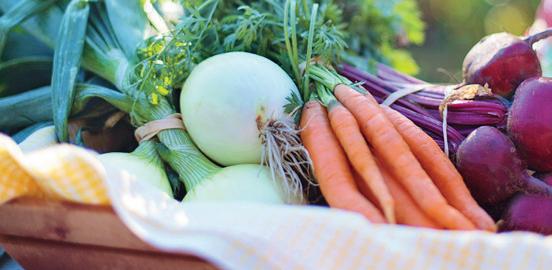








Peter and Uncle Johnny. Try the muffaletta on a partiallycored French roll and throw in a couple of Italian sodas, then maybe pick up some colorful dried pasta to take home. Open Su–Th 10am–5pm, F–Sa 10am–6pm.
Estéban Restaurant
700 Munras Avenue
831.375.0176 • estebanrestaurant.com
At the heart of the downtown Monterey dining scene, Estéban Restaurant serves Spanish-inspired California cuisine made from local, seasonal ingredients, which can be enjoyed on the Mediterranean garden patio that now includes a classic pergola with toasty heaters. The menu features a selection of long-time Estéban favorites, as well as new dishes like Vieiras con Jamón (seared scallops, Baker's bacon, citrus oil, basil English pea purée, citrus supreme and asparagus ribbon) and grilled Secreto de Ibérico pork, with charred sweet peppers, ñora pepper paste, scarlet mustard frill and Picual olive oil. Open for dinner Su–Th 4:30–8:30pm, F–Sa 4:30–9pm. Brunch Sa–Su 9am–1:30pm. Grab & Go Breakfast M–F 7–10am. Tapas Happy Hour from 4:30–6pm daily.


Jacks Monterey
2 Portola Plaza 831.649.7830 • jacksatportola.com
Jacks Monterey provides a refreshing culinary experience in downtown Monterey, inside the Portola Hotel & Spa. Emphasizing local ingredients, high-quality seafood, and an award-winning wine and cocktail program, Jacks philosophy derives from globally-inspired traditions of California Cultural Cuisine. The atmosphere at Jacks is sophisticated—never pretentious. Open daily for breakfast 6:30–10:30am, dinner 4–10pm, and bar only F-Sa 10–11pm.
The Lantern Room
2600 Sand Dunes Drive
831.899.4544 • lanternroom.com
With incomparable views of the Pacific Ocean, The Lantern Room on the fourth floor of the Monterey Beach Hotel specializes in fresh seafood paired with produce from local farms and wines curated by renowned Monterey County winemaker Ian Brand. Culinary advisor Paul Corsentino and executive chef Jose Velasquez have enlisted a roster of passionate fishermen and farmers to delight diners, and also offer a full bar with carefully crafted cocktails. Don’t miss the crispy Monterey Bay grenadier appetizer and the black cod cioppino or the mushroom forager’s omelet for breakfast. Open daily for breakfast 7–11am and dinner 5–10pm.


Peter B’s
2 Portola Plaza
831.649.2699 • peterbsmonterey.com
Reopening early Summer 2025 after a multi-million dollar renovation, Peter B’s debuts a fresh look with wood, stone, and copper accents inspired by Monterey Bay. Monterey’s original craft brewery and favorite sports bar offers a rotating selection of beers on tap, two happy hours, a lively sports bar atmosphere, and outdoor dining on a pet-friendly, heated patio with fire pits. A go-to spot for locals and visitors alike. Visit the website for reopening date and hours.
Schooners Monterey
400 Cannery Row
831.372.2628 • schoonersmonterey.com
Residents regularly vote Schooners Best Drink With a View, and they’re not wrong. The eye candy rolls from the waves crashing on the tidal zone below to Seaside and Santa Cruz beyond, and the sippers are memorable. But that’s only part of the program. The seafood-centric menu ups the atmospheric effect with contemporary takes on a Monterey cioppino pot, seared sea scallops, Dungeness crab dip and Thai-style steamed mussels. Specialty cocktails, organic fresh-pressed juices and curated small batch beers and wine complete the affair. Open 7am–9pm daily.

Sea Harvest Restaurant & Fish Market
598 Foam Street
831.626.0547 • seaharvestmonterey.com
This fresh and casual seafood spot near Cannery Row is perfect after a day exploring the Monterey Bay Aquarium. There are grilled entrées and lots of fried options with chips, including calamari, clams, prawns, scallops and oysters. Try Sea Harvest’s popular clam chowder or a basket of crispy artichoke hearts. Open daily 9am–7pm.

Tidal Coffee
400 Cannery Row
831.645.4030 • tidalcoffeemonterey.com
Thoughtful coffee blends with organic beans headline here, but picnic-lunch goodies and house-made sandwiches also come recommended. Monkey bread, maple scones and almond croissants feature in early, followed by soups, salads and panini like the roast beef with horseradish aioli, grilled onion, slices tomatoes, smoked mozzarella and pickled peppers. The coffee shop aesthetic is cute, but the adjacent decks overlooking Monterey Bay present a superior spot to spoon a fig-mascarpone or vegan chocolate-hazelnut gelato with a fresh cortado. Open Tu–Th 6am–noon, F–M 6am–4pm.
Tidewater
2600 Sand Dunes Drive
831.394.3321 • tidewatermontereybeach.com
The only truly beachfront dining experience on the Monterey Bay, Tidewater is located outside the newly redesigned Monterey Beach Hotel. It’s a perfect spot to watch the waves and catch a sunset, while indulging in Tidewater’s handcrafted cocktails or a glass of local wine or beer. Cozy up to the fire pits complete with blankets and lounge seating. Nibble on light bites like oysters, shrimp tacos or steamed mussels in Thai coconut curry broth or order a cheese and charcuterie plate to share. Open daily 4–9pm.

Sea Harvest 2420 Highway 1
831.728.7081 • @seaharvestmosslanding
Outdoor tables on a wooden deck overlooking Elkhorn Slough is the perfect place to enjoy fresh seafood from one of the Deyerle family’s fleet of fishing boats, the same family that runs the restaurant. Choose from grilled catch of the day, shrimp Louie, fish and chips or some of the best Bajastyle battered fish tacos around. Open daily 11am–7pm.

Woodward Marine Market 10932 Clam Way
831.632.0857 • woodwardmarinemarket.com
Moss Landing, population a few dozen, enjoys an outsized number of beaches, marine research institutes and, thankfully, eateries. Its newest ranks among the most inviting. WMM occupies a historic location at the Moss Landing Harbor fuel dock that delivers place-appropriate fuel for the eager eater. Clam chowder and Monterey Bay calamari lead the way on the appetizer front. A pair of salads offers roughage with style. Plates and bowls round out the menu—think bouillabaisse, fish and chips, Woodward burger, artichoke-prosciutto sandwiches and seared fish tacos. Local wines and Prosecco available, as well as local craft beer, including Alvarado Street, Other Brother, Fruition and Corralitos brewing. Open Tu–Sa 11:30am–6pm, Su 11:30am–4pm.

Café Guaraní 111 Central Avenue
831.747.1551 • cafeguarani.com
Family owned and operated, Café Guaraní is devoted to bringing traditional South American empanadas to the Monterey Peninsula. These are Paraguayan versions, with baked or fried options, meat filled or vegan. Chef-owner






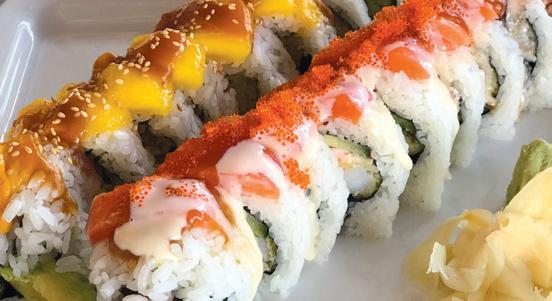







Liliana Rodas de Araujo has been making empanadas since she was six years old and is also known for her special occasion cakes, available by pre-order. The café also serves lunch sandwiches, yucca fries, croquettes and vegetarian chili. There’s a robust coffee program and several variations of yerba mate—a stimulating South American herbal tea. Open M–F 8am–3pm, Sa–Su 8am–5pm.

The Grill at Point Pinos
79 Asilomar Avenue
831.375.1313 • grillatpointpinos.com
Serving breakfast, brunch and lunch seven days a week, The Grill at Point Pinos is a beloved local’s secret located at the Pacific Grove Golf Links. In addition to views of the greens and the ocean beyond, owner Tamie Aceves makes sure the food and hospitality are way above par. Award-winning huevos rancheros and chilaquiles top the breakfast menu, but there are also eggs Benedict and bloody Marys garnished with Baker’s Bacon. Ingredients are fresh and local, and the restaurant is green certified. Open Su–M 8am–5pm, Tu–Sa 8am–7:30pm.

Julia’s Vegetarian
1180 Forest Avenue, Suite F
831.656.9533 • juliasveg.com

Voted the best vegetarian/vegan restaurant on the Monterey Peninsula for more than 10 years running, Julia’s features inspired vegan, vegetarian and gluten-free food with a touch of class. Julia’s is well known for its fresh seasonal exotic mushrooms, elevated vegan desserts and house-brewed kombucha on tap. Julia’s expanded breakfast menu is a great way to start your day, featuring egg sandwiches, candy cap French toast and a cordyceps brunch bowl. Plus, everything can be made vegan! Open daily for breakfast, lunch and dinner. Passionfish
701 Lighthouse Avenue
831.655.3311 • passionfish.net
Specializing in sustainable seafood and locally grown produce, Passionfish is a perennial award winner and a James Beard Award finalist for its Outstanding Wine Program—with an extensive selection of local and European wines at close-to-retail prices. Mother-son owners Meral Alpay and Rasit Berk Guvenc continue the restaurant’s legacy with favorite dishes like Dungeness crab salad with avocado and spicy ginger vinaigrette, smoked trout ceviche tostaditas, albacore tuna with artichoke-basil caponata and sea scallops with tomato-truffle butter, poached lettuce and savory rice custard. Open nightly 5–9pm.
Spotted Duck
542 Lighthouse Avenue, Suite 102
831.920.2662 • spottedduckpg.com
Spotted Duck brings a welcoming environment to downtown Pacific Grove. Chef/ owner Jerry Regester is hands on each night, preparing the menu with his creativity and capturing the essence of the changing seasons. A small restaurant with big flavor, a bistro-style menu and a French perspective, its motto is, “Duck is the new chicken!” Also offering great wines, local beer on tap and fun soju-based cocktails. Located in the historic Holman Building at the gateway to downtown Pacific Grove, Spotted Duck is considered one the best neighborhood restaurants by locals. Come eat, come experience the memorable food and hospitality that will have you coming back for more. Open Th–M 5–8pm

Lolla 201 Third Street
831.593.5064 • lollasjb.com
Owner Sarah Griss has created a soup, salad and sandwich luncheonette in an adobe building right across the street from San Juan Bautista Historic Park. Lolla sources healthy food from local farms and food producers, giving customers a quick and convenient way to eat locally, seasonally and deliciously. Daily special soups are not to be missed. Open W–Su 11am–3pm.


Margot’s Ice Cream Parlor
211 Third Street
831.623.9262 • margotsicecreamparlor.com
Bringing smiles to the people of San Juan Bautista for 25 years, Margot’s was originally opened as a retail outlet for wonderful handmade candies, including chocolatedipped apricots, almond butter crunch, marshmallows, oreos, grahams and pretzels, as well as 10 flavors of chocolate truffles. In addition, it offers 28 flavors of Lappert’s ice cream, espresso drinks and Dole pineapple whip. Open M–Th 11am–7pm, F–Su 11am–8pm.
The Smoke Point
206 Fourth Street
831.593.5009 • thesmokepoint.com
When Michelin-starred chef Jarad Gallagher wanted a project for his own community, he immediately thought of barbecue. San Juan Bautista holds a massive rib cookoff every spring and The Smoke Point is the restaurant he opened mid-pandemic for year-round BBQ. While most folks come for the brisket, ribs, tri-tip and pulled pork, don’t miss creative sides like Fuji apple and ginger coleslaw or crispy Brussels sprouts. There is local craft beer on tap and an imaginative weekend BBQ brunch. Open W–Th noon–8pm. F noon–9pm. Sa 10am–9pm. Su 10am–8pm.


Vertigo Coffee Roasters
81 Fourth Street
831.623.9533 • vertigocoffee.com
Artisanal coffee roasted on site as well as fresh pastries baked in-house, brunch items, local craft beers and wines, plus wood-fired pizzas with naturally leavened, twice fermented sourdough crust have made Vertigo a locals’ favorite as well as a great find for visitors en route to the San Juan Mission, Pinnacles or other area attractions. Check website for current hours.
Windmill Market
301 The Alameda
831.623.2956
San Juan’s friendly neighborhood grocer has everything you need for a picnic or quick meal, with ample outdoor tables and booths around the windmill. A full-service deli counter and taquería offers made-to-order sandwiches and Mexican specialties like tortas, burritos, tamales and combo plates. There is also a salad bar, a hot bar and plenty of grab-and-go items. Open daily 6am–9pm.


Avanti Restaurant
1917 Mission Street
831.427.0135 • avantisantacruz.com
A local’s favorite since the 1980s, Avanti pioneered farmto-table dining and the use of organic, local vegetables, pasture-raised meats and sustainable seafood. Favorite dishes include calamari fritti, Brussels sprouts with roasted butternut squash and fresh pappardelle pasta with pork meatballs. On Sundays it offers Fogline Farm fried chicken dinners. Diners can choose the upscale contemporary dining room, a heated outdoor patio or the garden room. A full bar features seasonal cocktails, along with local wines and craft beer. Open W–Su 5–9pm.
Bookie’s Pizza 1315 Water Street bookiespizza.com
Located inside the Santa Cruz outpost of Sante Adairius Rustic Ales, Bookie’s Pizza is owned by fine dining veteran chef Todd Parker and offers “inauthentic” Detroit-style square pies. Each pizza is made using the best seasonal ingredients from local farms, fishermen and foragers. Dough is made with organic flour, naturally leavened for 48 hours, and each pizza comes with its own unique sauce. Open Su–Th noon–9pm. F–Sa noon–10pm.

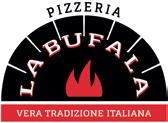
AUTHENTIC NEAPOLITAN PIZZA AND ITALIAN CLASSICS
105 Walnut Avenue • eathookandline.com
831.225.0434 • 4-9pm Thursday through Monday
A modern California seafood eatery, now open in downtown Santa Cruz.

Tune in Fridays around noon for Edible’s Mark C. Anderson and his Friday Found Treasures on 94.7 FM and streaming worldwide at KRML.com!
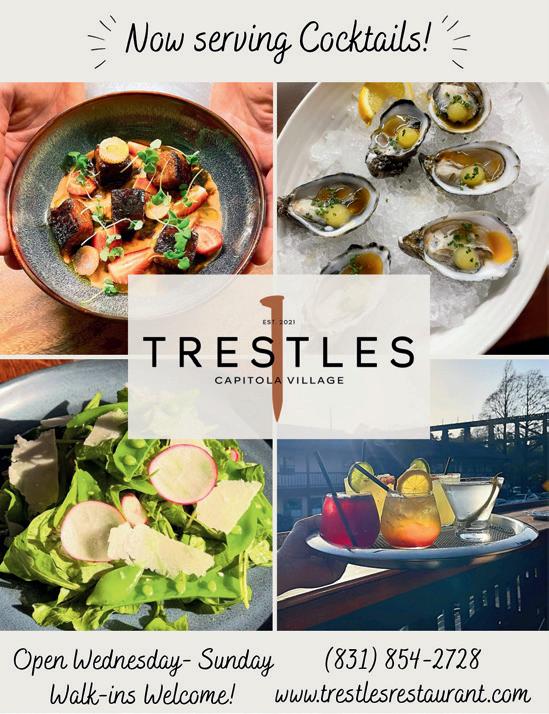




Charlie Hong Kong
1141 Soquel Avenue
831.426.5664 • charliehongkong.com
Charlie Hong Kong has been providing the Santa Cruz community with healthy, sustainable, affordable and high-quality food since 1998. The colorful, casual eatery’s delicious fusion of Southeast Asian influences and the Central Coast’s local organic produce have made it an inclusive, family-friendly, neighborhood favorite. Its slogan is “love your body, eat organic,” and its cuisine is proof that fast food can be good for you. All signature dishes are vegan with the option to add meat or fish. Gluten-free options are available. Dog friendly. Open daily 11am–10pm.
Crow’s Nest
2218 E. Cliff Drive
831.476.4560 • crowsnest-santacruz.com
A perfect spot to enjoy breakfast and lunch or catch a dinnertime sunset over the harbor, the nautical-themed Crow’s Nest is a Santa Cruz institution that never goes out of style. There’s always something happening, from live music to comedy nights and happy hours. Famous for its salads, house-smoked salmon and seafood entrées, the Crow’s Nest is a member of Seafood Watch and is a certified green business. Open M–F 9am–8:30pm, Sa–Su 8am–8:30pm.

Far West Fungi
224 Laurel Street, Suite A101
831.226.2626 • farwestfungi.com
The air surrounding the cozy café in downtown Santa Cruz is always infused with the delightful scents of savory mushrooms and truffles. Each visit offers a fresh experience with the seasonal menu featuring a variety of cooked and fresh mushrooms, while the extensive selection of dried mushrooms, tinctures, books and cultivation supplies ensures your pantry stays stocked with rare foraged treasures. Indulge in must-try delights like candy cap mushroom cookies, hot mushroom empanadas and truffle grilled cheese, complemented by locally brewed kombucha on tap. Open daily 11am–5pm.
The Grille at DeLaveaga
401 Upper Park Road
831.423.1600 • delaveagagolf.com/dining DeLaveaga earns obsessive attention for its trails, golf and disc golf, and it also enjoys a worthy epicurean program. The grill’s backdrop enhances the experience, with absorbing views, an outdoor patio and deck, welcoming fireplace and well-appointed bar. Food goes continental- Californian, local and organic, starring breakfast and lunch dishes like the croissant Benedict, the “Moss Landing-style” breakfast sandwich, the DeLa Black Angus burger and the “wedge shot” Louie salad with crab, bay shrimp or both. Open W–Su 8am–3pm.

Hanloh Thai Food
1011 Cedar Street
831.854.7525 • hanloh.com
This community favorite from chef-owner Lalita Kaewsawang offers standout “nostalgic cooking rooted in Thai tradition,” at a residency inside the stylish Bad Animal bookstore. Bright flavors begin with Hatsu oysters with nam jimm dipping sauce and pomelo-grilled shrimp salad tossed with chili jam dressing and Thai herbs. Entrées include lemongrass black cod, claypot pork belly confit and double fried chicken thighs with coriander. That all comes complemented by friendly hospitality and a wide selection of natural wines. Open W–Su 5–9pm.
Hook & Line
105 Walnut Avenue
831.225.0434 • eathookandline.com
Chef Santos Majano makes a welcome return to the Santa Cruz dining scene with his own seafood concept restaurant. Hook & Line taps local fishermen for the best fish and shellfish, then adapts the menu, whether it’s octopus, mussels, California halibut or just-caught Monterey Bay

sardines. Oysters play a big role with a custom designed shucking station and several varieties on offer at all times. Happy hour all night Mondays and 4–5pm Th–Su features $2 oysters and special prices on wine and craft cocktails. Open Th–M 4–9pm.
Johnny’s Harborside
493 Lake Avenue
831.479.3430 • johnnysharborside.com
With sweeping views of the Santa Cruz Yacht Harbor, Johnny’s location assures fresh off the boat seafood. Steamed Dungeness crab with drawn butter is always a good choice in season, but don’t miss the clam chowder, fish and chips or Johnny’s authentic Italian-style cioppino. Crab-encrusted salmon, shrimp scampi and California halibut entrées are customer favorites, along with fish tacos, burgers and beer-steamed clams. Open T–Su noon–8:30pm. Closed M.


La Posta
538 Seabright Avenue
831.457.2782 • lapostarestaurant.com
A cozy neighborhood bistro not far from the Santa Cruz yacht harbor, La Posta chef Rodrigo Serna prepares traditional rustic Italian cuisine using local ingredients. The emphasis is on simple, seasonal selections, with the balance of the menu reflecting whatever produce is freshest right now. La Posta also offers a great selection of Italian wines and a heated outdoor patio. Open W–Th 5–8:30pm, F–Sa 5–9:30pm, Su 5–8:30pm. Closed M–Tu.
The Midway 1209 Soquel Avenue
831.427.7187 • themidwaysantacruz.com
Acclaimed Santa Cruz chef Katherine Stern pivoted from running a popular farmers market stand during the pandemic to opening her own restaurant at the end of last year. The vibe is sleek and modern, and the food is sophisticated. Whether you try the lemon verbena pancakes, the chicken chile verde or one of the salads from the daytime menu, all dishes star seasonal produce and ingredients from Stern’s farmers market friends. Dinner options change frequently and always include a house-made pasta and a vegetarian entrée. Check website for the most updated menu. Carefully selected wines, beer and coffee roasted by Cafe Delmarette are available. Open Th–M 11am–2pm and 5–8:30pm, Sa–Su until 9pm.


New Leaf Community Markets 1101 Fair Avenue
831.426.1306 • newleaf.com
The Westside New Leaf has a large deli counter and coffee bar, with a big selection of sandwiches, salads, bakery items, soups and other hot foods. You can eat at an instore counter or at tables outside. Open daily 7am–9pm.
The Penny Ice Creamery 913 Cedar Street
831.204.2523 • thepennyicecreamery.com
Lines out the front door of its converted Spanish bungalow are evidence of Penny’s popularity. All ice cream, including bases, is made from scratch on the premises using local organic ingredients when possible. Dozens of exotic flavors rotate seasonally, but two favorites are chocolate caramel sea salt and strawberry pink peppercorn. Open daily noon–11pm.

The Picnic Basket 125 Beach Street
831.427.9946 • thepicnicbasketsc.com
Across the street from the main beach, owners of The Penny Ice Creamery offer an alternative to boardwalk fast food. Sandwiches, organic salads, coffee and beer, all from local food artisans, and of course Penny’s popular ice cream, are all on offer to eat in or outside with your feet in the sand. A selection of grab-and-go foods, drinks and beach essentials are available in the newly expanded restaurant. Open daily 7am–4pm.
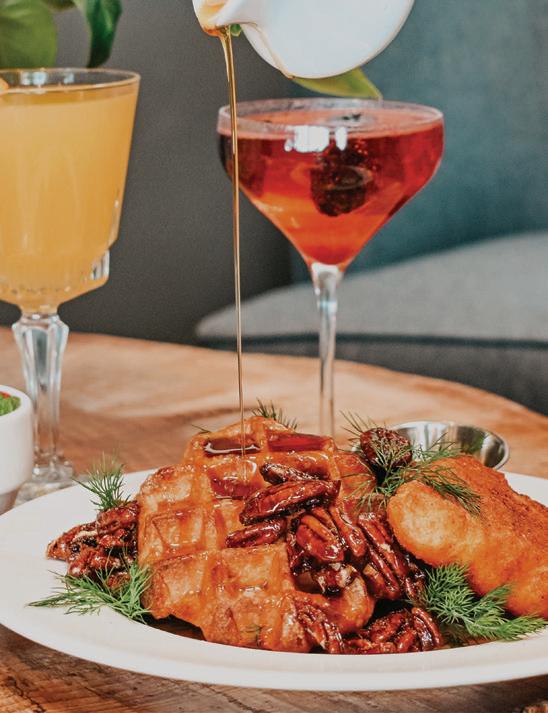
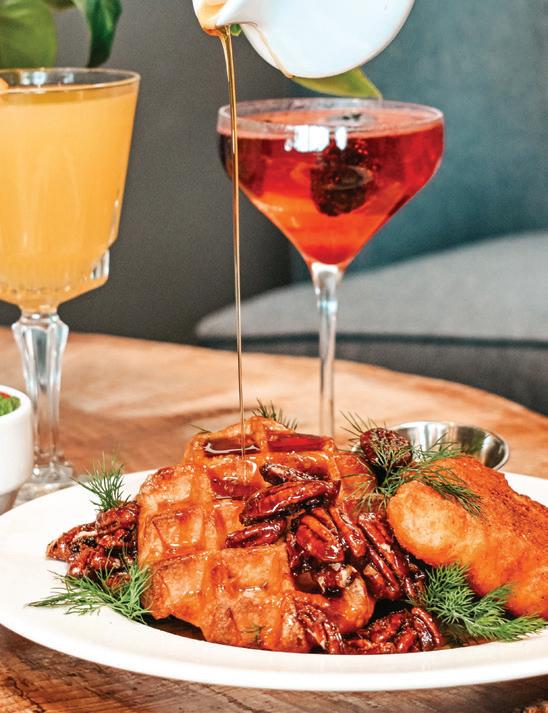
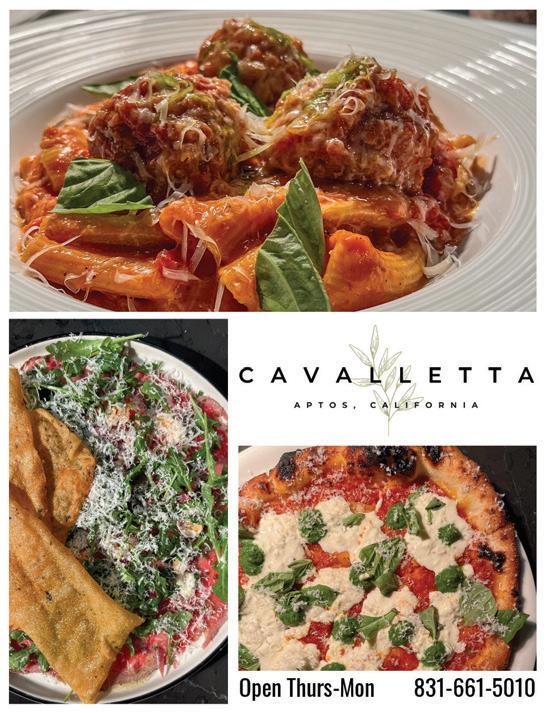

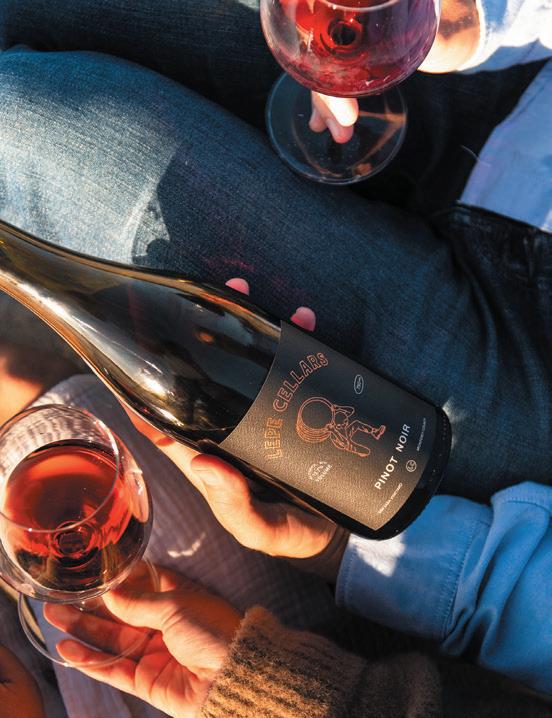


Pizzeria La Bufala
Abbott Square Market, 725 Front St.
831.999.0301 • pizzerialabufala.com
Located in downtown Santa Cruz’s lively Abbott Square Market, Pizzeria La Bufala has been serving authentic Neapolitan pizza since 2017. This cozy spot offers a wide variety of wood-fired pizzas along with favorite Italian dishes like lasagna, gnocchi, meatballs, eggplant parmigiana and tiramisu. The authentic Italian tradition shines through in every dish, making it a beloved destination for tourists and locals alike. Open Su–Th 11:30am–8:30pm, F–Sa 11:30am–9pm.
Staff of Life
1266 Soquel Avenue
831.423.8632 • staffoflifemarket.com
A Santa Cruz landmark, Staff of Life started in 1969 as a small natural foods bakery and has grown over the years into a full service natural foods supermarket known for its local organic produce, seafood and natural meats as well as an extensive bulk department. Deli items and foods from the hot bar can be enjoyed at the Café del Sol. Open daily 8am–9pm.
Vim Dining & Desserts
2238 Mission Street
831.515.7033 • vimsantacruz.com
Chef-owner Jesikah Stolaroff brings creativity and precision to her elegant New American cuisine, giving diners a clue to her background as a fine dining pastry chef. The seasonal menu might include appetizers like kimchi rice fritters, lamb meatballs or cherry burrata, with entrées such as pineapple trout, leek butter fettuccine or coriander crusted filet mignon—served in a tasteful dining room with a full bar or on the outdoor patio. Save room for unforgettable desserts and check website for monthly afternoon teas. Open W–Sa 5–8:30pm.



The Penny Ice Creamery
262 Mount Hermon Road, Suite 104 831.204.2523 • thepennyicecreamery.com
Open Su–Th noon–9:30pm, F–Sa noon–10pm. See The Penny description under Santa Cruz for more.
Other Brother Beer Co.
877 Broadway Avenue 831.747.1106 • otherbrotherbeer.com
The main attraction here is fresh, delicious beer. However, the brewery’s brand new kitchen inspires a visit on its own. Not coincidentally, dishes are designed to pair poetically with Other Brother’s house beers. The menu features goodies like its signature smashburger, fried chicken sandwich, mushroom melt, wings, fries, and creative and refreshing salads with brunch on the weekends. Check out the full menu on the website and visit the brewery taproom open M–Th 11:30am–9pm, F 11:30am–10pm, Sa 9am-10pm, Su 9am-8pm.
Coffeeville 948 East Lake Avenue facebook.com/coffeevillesantacruz
Local family owned and operated, Coffeeville prides itself on its dedication to single origin coffees roasted in small batches. It’s the perfect spot to enjoy a cappuccino or an espresso, offering a warm and lively atmosphere that gives a great start to your day. Organic teas, affogatos, pastries and breakfast sandwiches are also on the menu. Open M–Sa 7am–4pm,
8am–3pm.

Fruition Brewing & Kitchen
918 East Lake Avenue
fruitionbrewing.com
Fruition serves seafood and comfort food with delicious craft beers made on-site. The brewpub offers a rotating selection of beers with attention to balance, using the finest local, organic and California-grown ingredients with attention to balance and refreshing precision. The kitchen cooks with the seasons, featuring stunning snacks, salads, soups, outstanding oysters and gourmet grilled cheeses to pair with the super fresh beers, local cider and wine. Check their calendar for events in the tasting room and on the pet-friendly patio, including First Friday art, trivia nights and karaoke. Open W–Th noon–9pm, F–Sa noon–10pm, Su noon–8pm.
Hong Kong Garden
1012 E. Lake Ave.
831.724.1188 • qmenu.us
Watsonville’s go-to spot for fresh Chinese food, Hong Kong Garden offers dine in and take out service. There is a friendly, family vibe and a large dining room tucked into a corner of the East Cliff Village shopping center. Reasonably priced classic Chinese dishes are prepared to order, including Hong Kong style noodles and sizzling rice soups. Two dozen lunch specials, including rice, come in at $10 or $11. Open W–M 11:30am–8:30pm.

Ozzy’s Pizzeria
1036 East Lake Avenue
831.319.4464 • ozzyspizzeria.com
Ozzy’s motto is “Pizza is Life,” and owner Tim Silva’s casual yet creative style translates to both the ambiance and the food. Crowned World Pizza Maker of the Year in 2015, Silva makes sure everything is made from scratch, using organic ingredients, including the sauces and the outstanding sourdough crust—which is expertly charred in the wood-fired oven. Vegan, vegetarian and glutenfree options are available, and online orders can be placed through the website. Open Su–M noon–8pm, W–Th noon–8pm, F–Sa noon–9pm. Closed Tuesday.

Silver Spur
1040 East Lake Avenue
East Lake Village is excited to add a Santa Cruz County institution to its dining roster, Silver Spur! Just opened in March of this year, the new restaurant specializes in breakfast and lunch, offering a similar menu to the origi nal Silver Spur restaurant in Soquel, opened in the 1960s. Loyal customers come for signature orange rolls, cinna mon rolls, bread pudding and dozens of egg dishes. Father and son owners Juan Valencia and Daniel Govea also offer homemade soups, sandwiches and heartier items like chicken-fried steaks, oven-roasted turkey and roast beef.



Staff of Life
906 E. Lake Avenue
831.726.0240 • staffoflifemarket.com
Opened in 2021, Staff of Life’s second store in Watsonville is its first and only branch. The store is sustainable down to its bones and includes all the natural groceries, organic produce and includes all the natural groceries, organic produce and baked goods you would find at the Santa Cruz store, along with a juice and smoothie bar, freshly made sushi, a gelato bar, a full deli and a hot bar. Open daily 8am–8pm

Sushi Qu
952 East Lake Avenue
831.319.4567 • instagram.com/sushiqu1
The place to go for sushi, sashimi, tempura and other Japanese specialties, Sushi Qu puts the emphasis on freshness and flavor. Menu items are available for dine -n or takeout, and if you’re in need of platters for your next event, Sushi Qu can do that as well. Check out the monthly specials on Instagram and Facebook. Open Tu–Th 11:30am–2pm and 5–8pm, F 11:30am–2pm and 5–8:30pm, Sa 11:30am–2:30pm and 5–8pm.










Las Micheladas taps a magnetic combo of Michoacán and Japan in Hollister
BY ROBERT ELIASON
In a town full of taco trucks, taquerias and traditional Mexican restaurants, Hollister’s Las Micheladas Bar & Grill finds identity by way of Baja seafood dishes that embrace Japanese influence.
Co-owner David Ramirez celebrates the heritage of what results.
“We explore the 100-year-old traditions of the Puerto Vallarta and Sinaloa seafood industries,” he says. “We put them together to create a fusion which is based on the ingredients we import from Mexico, which you cannot duplicate elsewhere anywhere in the world.”
Bold words, yes. Bold flavors, yes again.
Born in Michoacán, Mexico, Ramirez came to the United States in 1994. His interest in Japanese food led him to train with San Francisco Bay Area chefs who, per Ramirez, demonstrate more than sashimi dexterity.
“I learned customs and the skill sets for the sushi business,” he says. “And I became more literate with what the Japanese and Mexican culinary sides offered.”
One key to his seafood items proves easily apparent, namely the high quality and big size of the shrimp he curates from Mexico through Grupo Rio Yaqui.
“The Pacific Coast of Mexico is blessed with a temperature that allows shrimp to grow to their sturdiness,” he says. “This crunch and the texture allow Pacific shrimp to stand out from every other shrimp in the world.”
The signature dish at Las Micheladas is camarones algobien, skinned shrimp deep-fried in tempura and topped with a spicy house mayo and sushi sauce. Their counterpoint is the camarones zarandados, with shrimp still in the shell, and sautéed with Mexican red chile peppers.
“The [algobien] ultimately jumps into the whole of Japanese flavors,” Ramirez says. “It really catches you up with this style. The [zarandados] represents Nayarit and highlights the local demographics we tie into. They’re the best of both worlds.”
The sushi menu shows a similar flair for fusion. The top seller is the Hot Cheetos Roll, containing spicy crab, cream cheese and shrimp tempura, topped with avocado and zingy crumbs of the popular corn snack, then drizzled with spicy mayo and unagi sauce.
“It’s got the tempura, a crunch and the shrimp itself,” he says, noting Michoacanans love sushi combined with Mexican ingredients. “It seems like they were always meant to be together, right?”
As its name implies, the restaurant offers various michela-
The Las Micheladas’ “Beautiful Margarita” arises from blue agave tequila, orange liqueur, a house blend of edible flowers steeped in vodka, lime juice and syrup, and comes with a dehydrated lime slice and salted rim.
das, including an extravagant Super Michelada, made with a choice of beers, a shot of tequila, clamato mix and 12 cooked shrimp. It also crafts additional drinks boasting complex mixes, syrups and elixirs, like the house-made butterfly flower liqueur.
While fusion dishes comprise most of the menu, Ramirez contends birra is the backbone of his restaurant—and has helped define the family nature of the business.
The 100-year-old recipe used, based on slow-cooked chuck roll and beef knuckle, comes from his grandmother, Maria del Refugio Cuquita.
“I’m very blessed to continue on her legacy, from how she would toast her spices [to] the many things that go into the seasoning,” he says. “Ultimately, the connection between the food and the love is important, so the customer can feel the energy we put into making it.”
The top seller is the quesabirria, which Ramirez keeps at $11.95 as a nod to his upbringing, when his family picked strawberries and money was tight.
“I want everybody in my community to be able to afford one plate when they come here,” he says. “It's one of my grandmother’s recipes that I want everybody to taste.”
Robert Eliason has spent 40 years in the used and rare book trade, 15 years as the officially unofficial photographer for El Teatro Campesino and 12 years as a photojournalist and reporter.





